Chemistry and Chemists № 3 2023
Journal of Chemists-Enthusiasts
| Content | Chemistry experiments - video | Physics experiments - video | Home Page - Chemistry and Chemists |
|
Chemistry and Chemists № 3 2023 Journal of Chemists-Enthusiasts |
Natural water and chemical reagents (demonstration model of water treatment process) - p.3, 4 V.M. Viter |
|
Having noticed a mistake in the text, allocate it and press Ctrl-Enter
Lake water, potassium hydroxide and iron (III) chloride - p.3
In previous experiments, we took water from the lake, the water was yellow-green and cloudy, as a result, we got clear and colourless water (it is undrinkable, but water disinfection is a separate issue). After the experiments, 300 ml of the sample remained (approximately). The remains of the sample were kept for 5 days at room temperature (25+°C - summer). Then, I decided to check how an excess of an alkali acts on the lake water. This time, the purpose was not water purification, but I would like "to see what happens."I take a bottle with the rest of the sample, and... Surprise, surprise! What a surprise? Unpleasant one, of course... At the time of sampling, the water was green-yellow and cloudy, but there were no visible solid particles. A day later, some dark green solid particles appeared in the liquid. Then I did not pay attention to it. But after five days, a lot of green flakes floated in the sample! The smell of water became unpleasant and rather specific. I do not doubt that flakes were the result of the growth of microorganisms, primarily algae. The smell was also the result of the vital activity of microorganisms. In a warm room, the water in the bottle heated up more than in the lake, so the microorganisms began to grow rapidly. In addition, in the lake, solid particles (after they formed in the volume of liquid) could settle to the bottom - and they settled. Also, they could float to the surface. In any case, the sediment did not enter the lake water sample during its sampling. But, if a precipitate forms while the water is standing in a bottle, it has nowhere to go from this container. I decided to conduct a trial experiment with this sample. If something works out, I will go to the lake and take a new water sample. 0.5 g of potassium hydroxide were dissolved in 2 ml of distilled water. 200 ml of a sample were poured into a glass (water from the lake after 5 days of being in a bottle), then I began to add a solution of caustic potash drop by drop, and it was mixed. As a result, big flakes formed in the glass, which quickly settled to the bottom and walls of the glass. A yellow-green precipitate formed. The solution became colourless. However, the water was still cloudy: discolouration occurred, but clarification did not. It is interesting (although nothing outstanding). |
|
В прошлых экспериментах мы взяли воду из озера - желто-зеленую и мутную, а получили прозрачную и бесцветную воду (непригодную, правда, для питья, но обеззараживание воды - отдельная тема). После экспериментов осталось примерно 300 мл пробы. Остатки пробы простояли 5 дней при комнатной температуре (25+°С - лето). Потом я решил проверить, как действует на озерную воду избыток щелочи. В этот раз - не с целью очистки воды, а просто, "чтобы посмотреть, что будет".
Беру бутылку с остатком пробы... Сюрприз-сюрприз! Какой? Неприятный, разумеется. В момент отбора пробы вода имела зелено-желтый цвет, была мутной, но не содержала твердых частиц (видимого размера). Через день в жидкости появилось немного темно-зеленых твердых частиц. Тогда я не придал этому внимания. А через пять дней в остатках пробы плавало много зеленых хлопьев! Запах воды стал неприятным и довольно специфическим. Не сомневаюсь, что хлопья - результат роста микроорганизмов, прежде всего - водорослей. Запах - тоже результат жизнедеятельности микроорганизмов. В теплой комнате вода в бутылке нагрелась сильнее, чем в озере, поэтому микроорганизмы стали интенсивно расти. Кроме того, в озере твердые частицы (после их формирования в объеме жидкости) могут осесть на дно - и они оседают. Могут - всплыть на поверхность. В любом случае осадок не попадает в жидкую пробу при ее отборе. А, если осадок образуется во время стояния воды в бутылке, из данной емкости ему деться некуда. Решил провести с этим образцом пробный эксперимент. Если что-то получится, сходить на озеро и отобрать новый образец воды. Растворил 0.5 г едкого кали в 2 мл дистиллированной воды. В стакан налил 200 мл пробы (вода из озера после 5 дней нахождения в бутылке) и стал по капле добавлять раствор едкого кали, перемешал. В результате в стакане образовались крупные хлопья, которые быстро осели на дно и стенки. Образовался желто-зеленый осадок. Раствор обесцветился. Однако, вода все еще оставалась мутной: произошло обесцвечивание, но не осветление. Интересно (хотя и ничего выдающегося). |
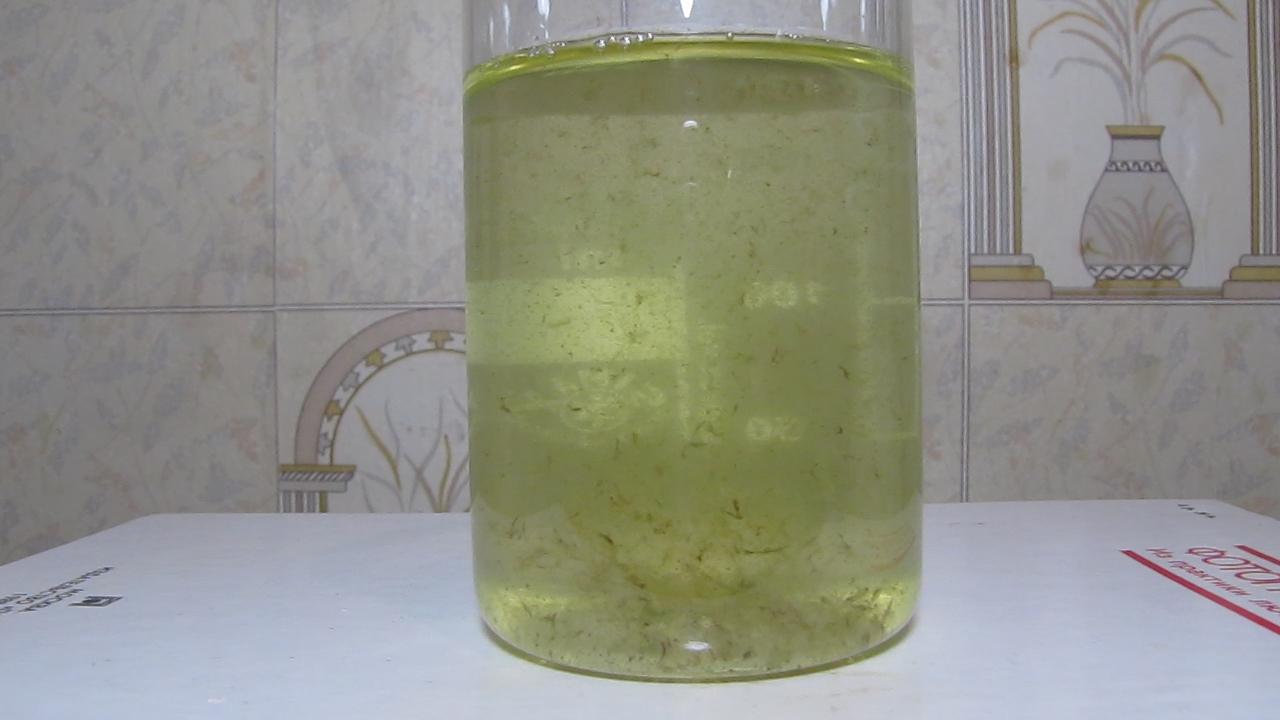
Lake water (the sample after a 5-day stay in a warm room) and potassium hydroxide |
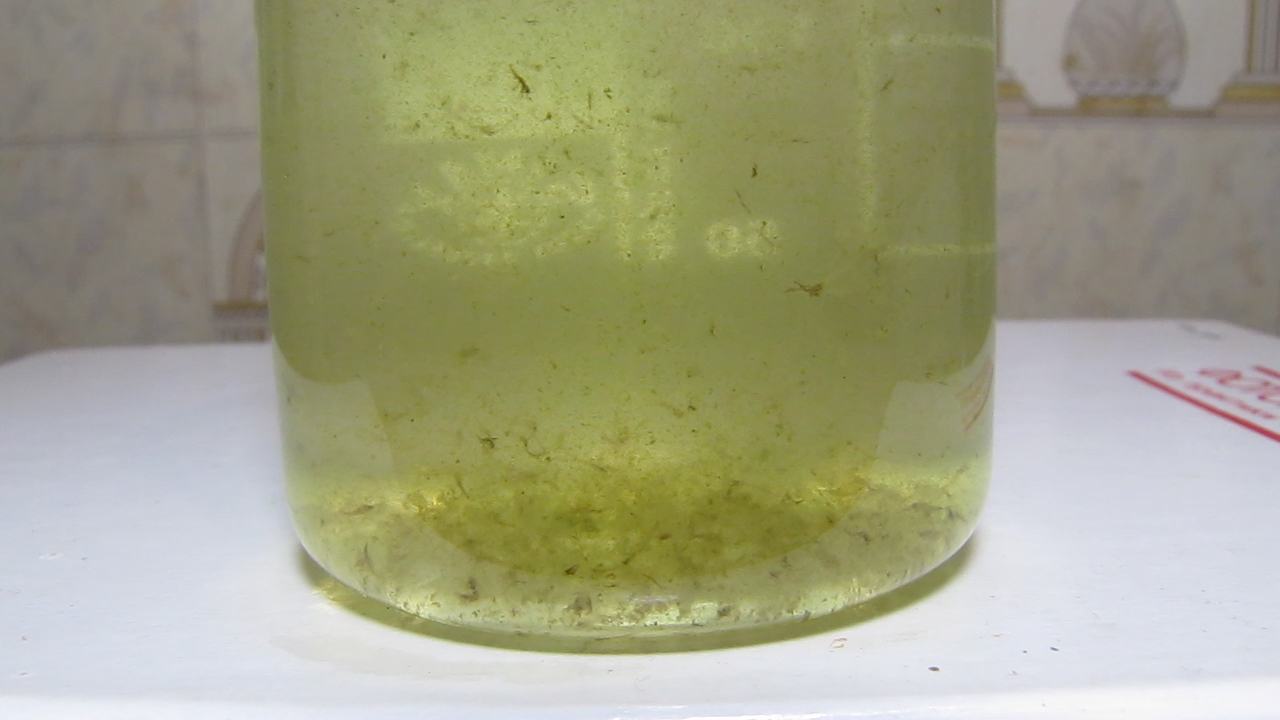
|

|
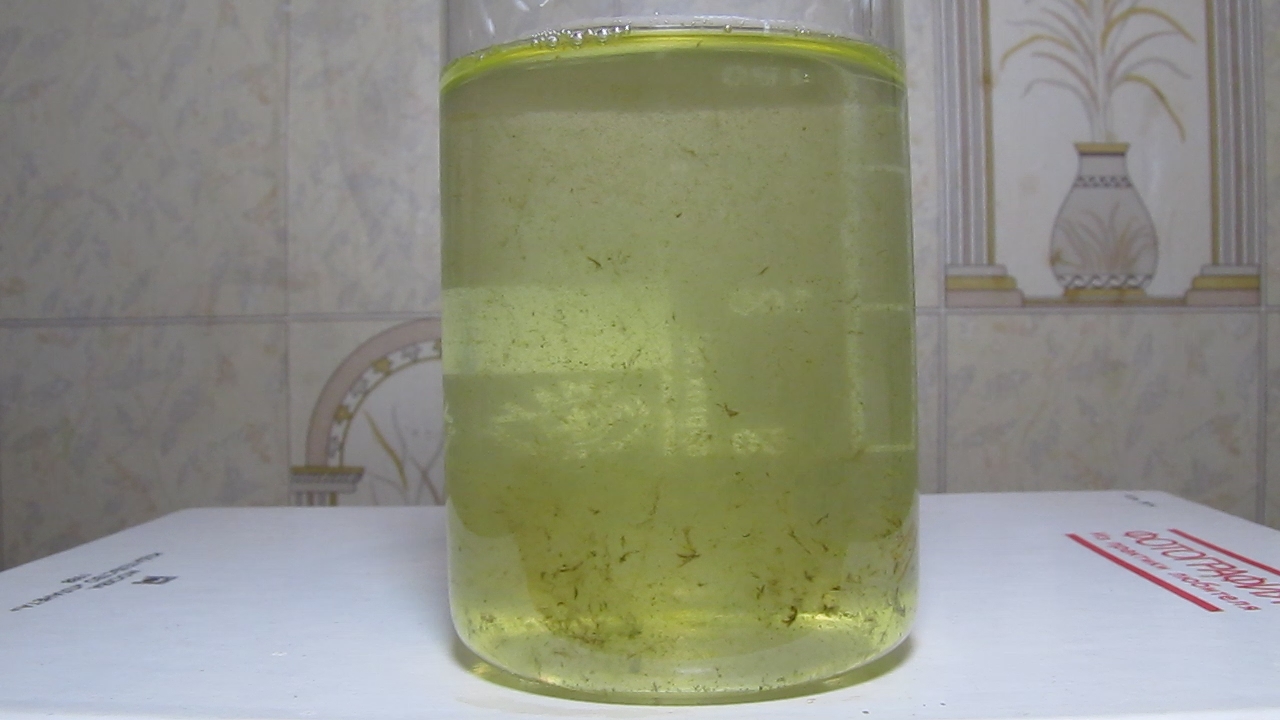
Potassium hydroxide was added |
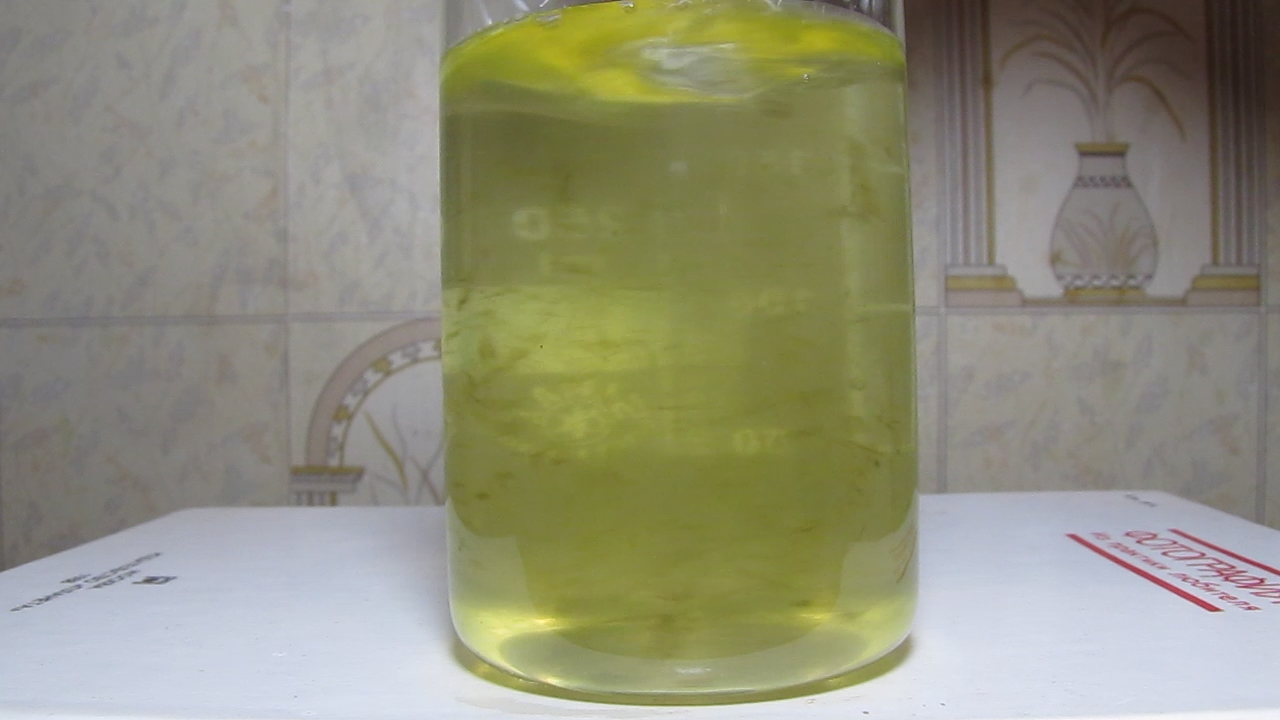
|

|
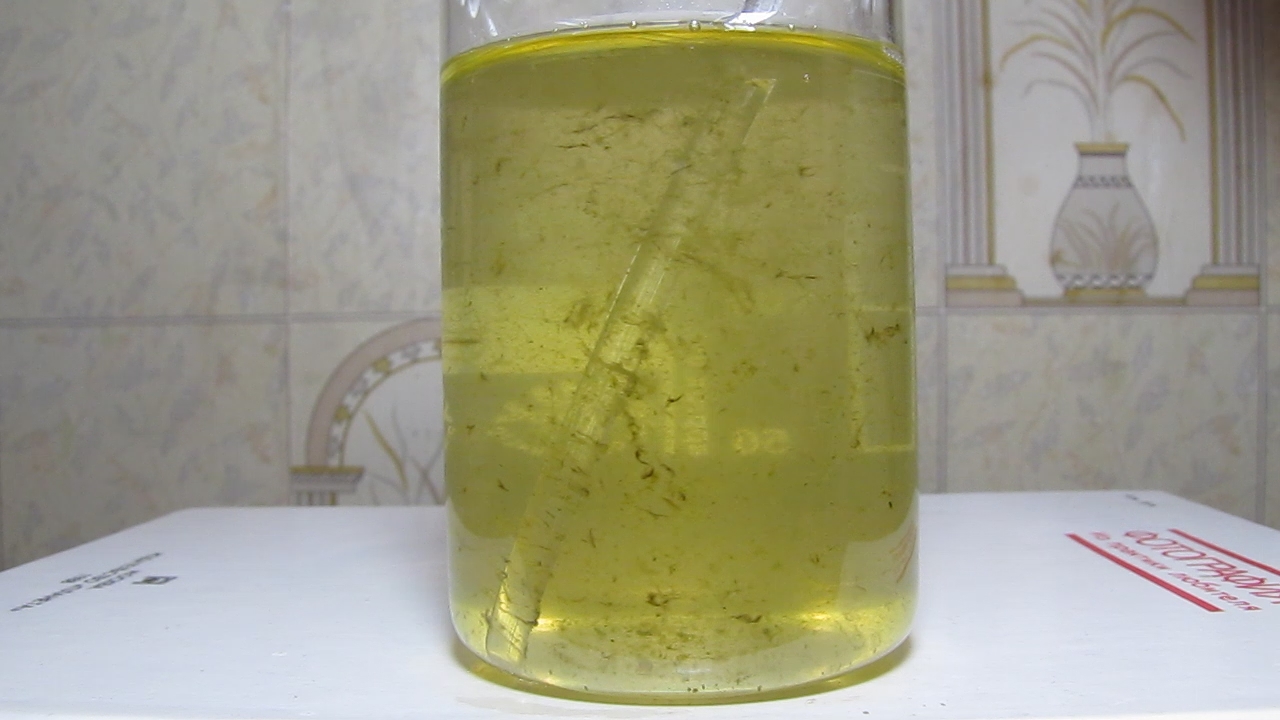
|

|
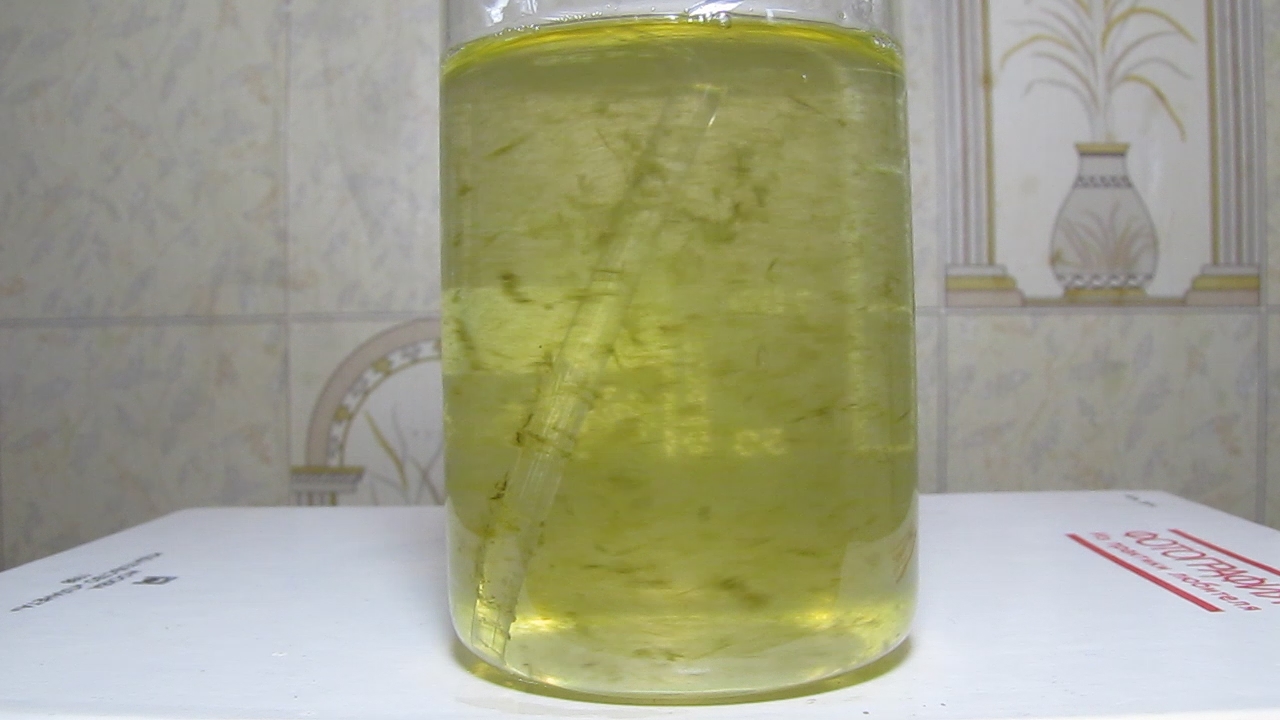
|
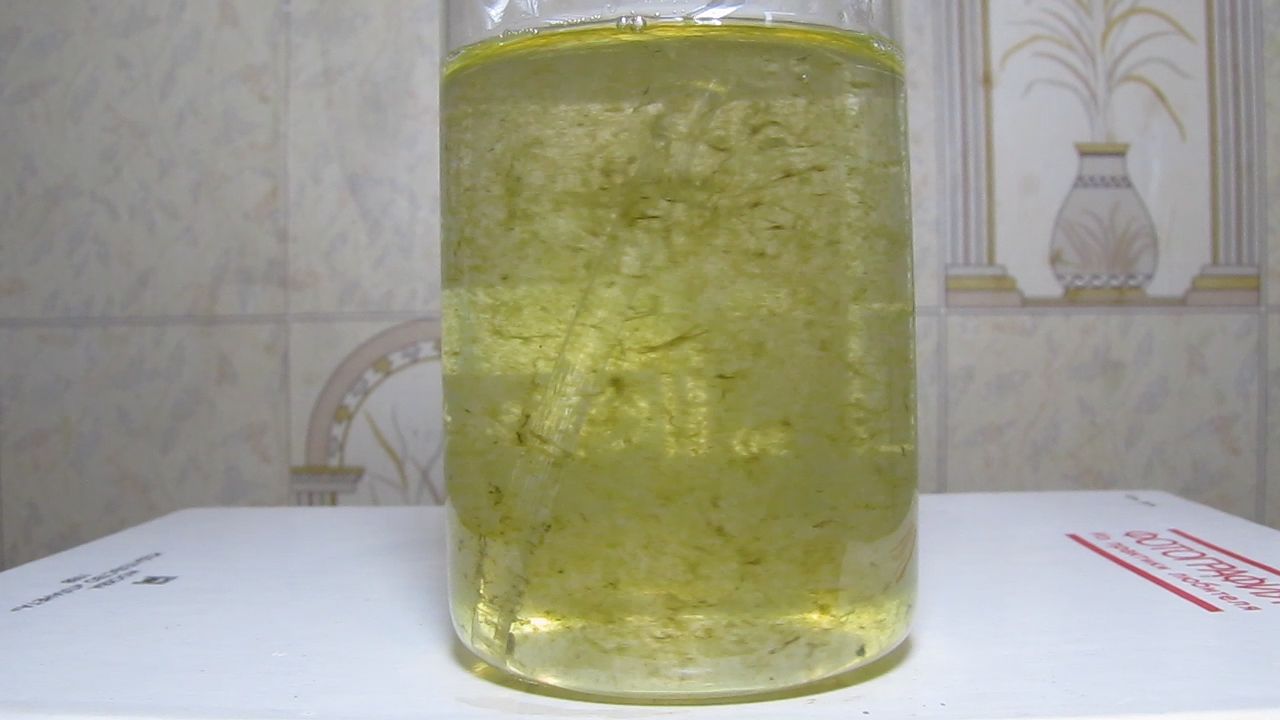
|
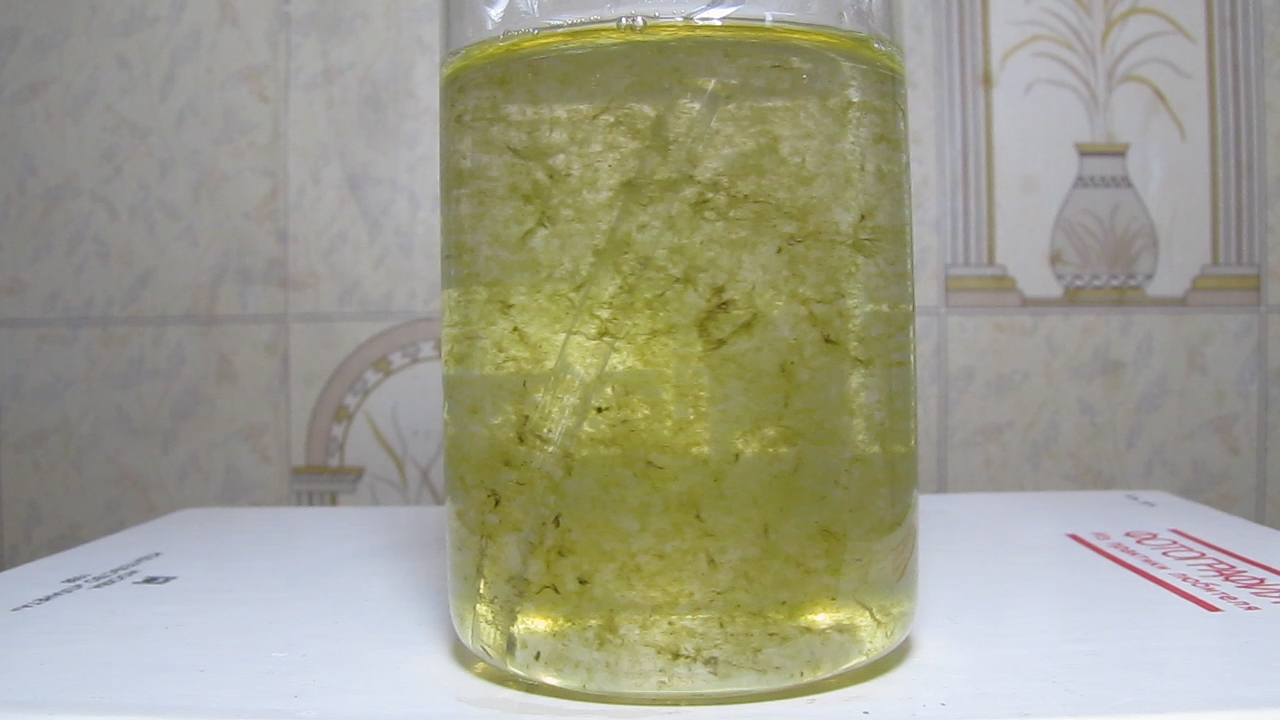
|

|
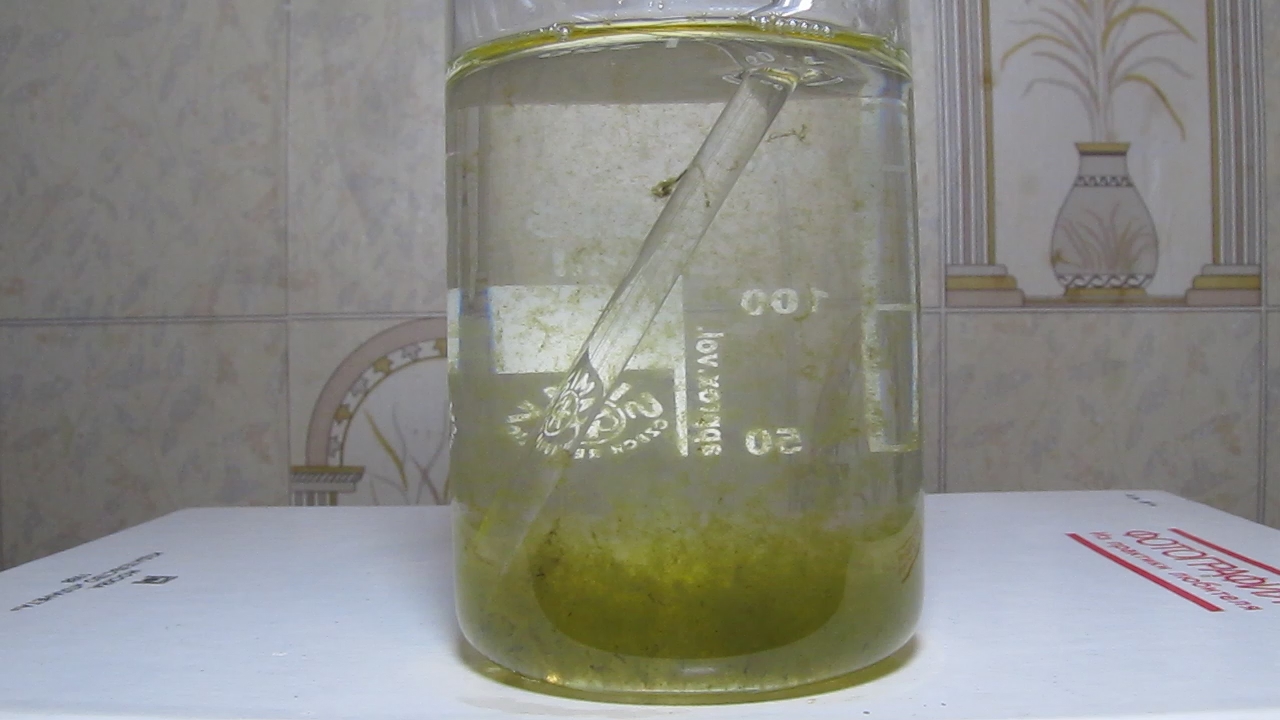
|
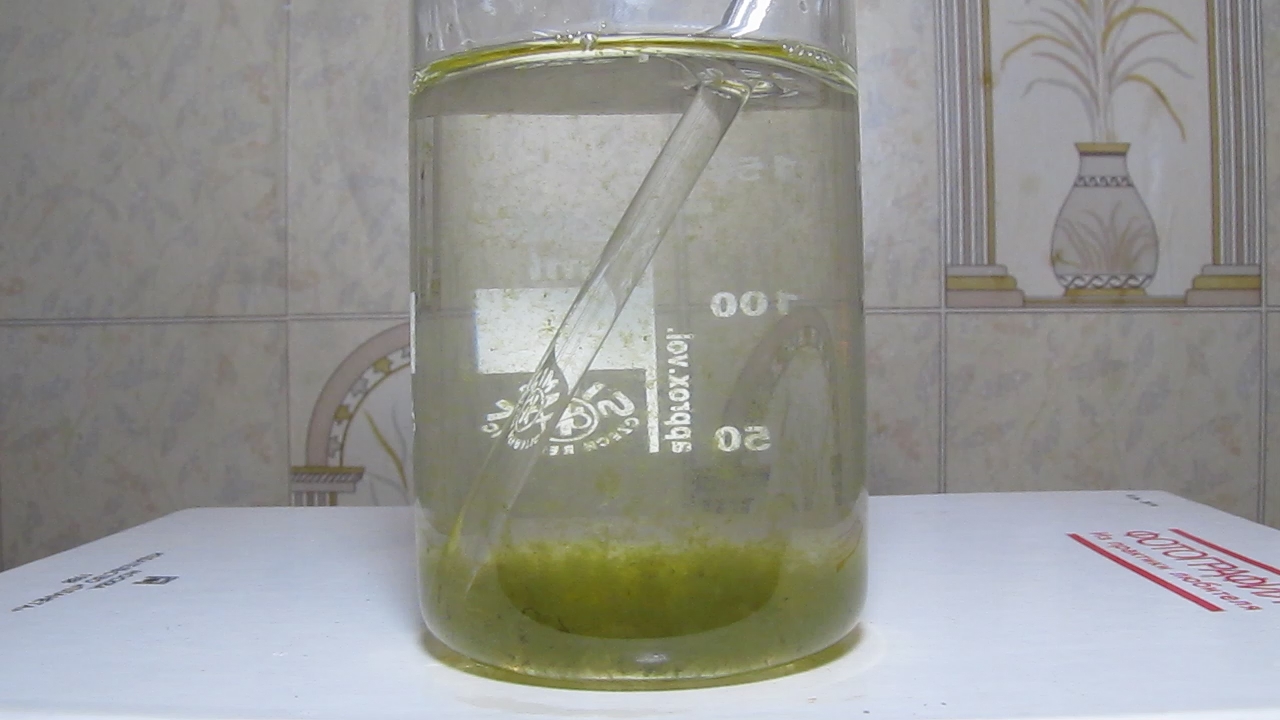
|
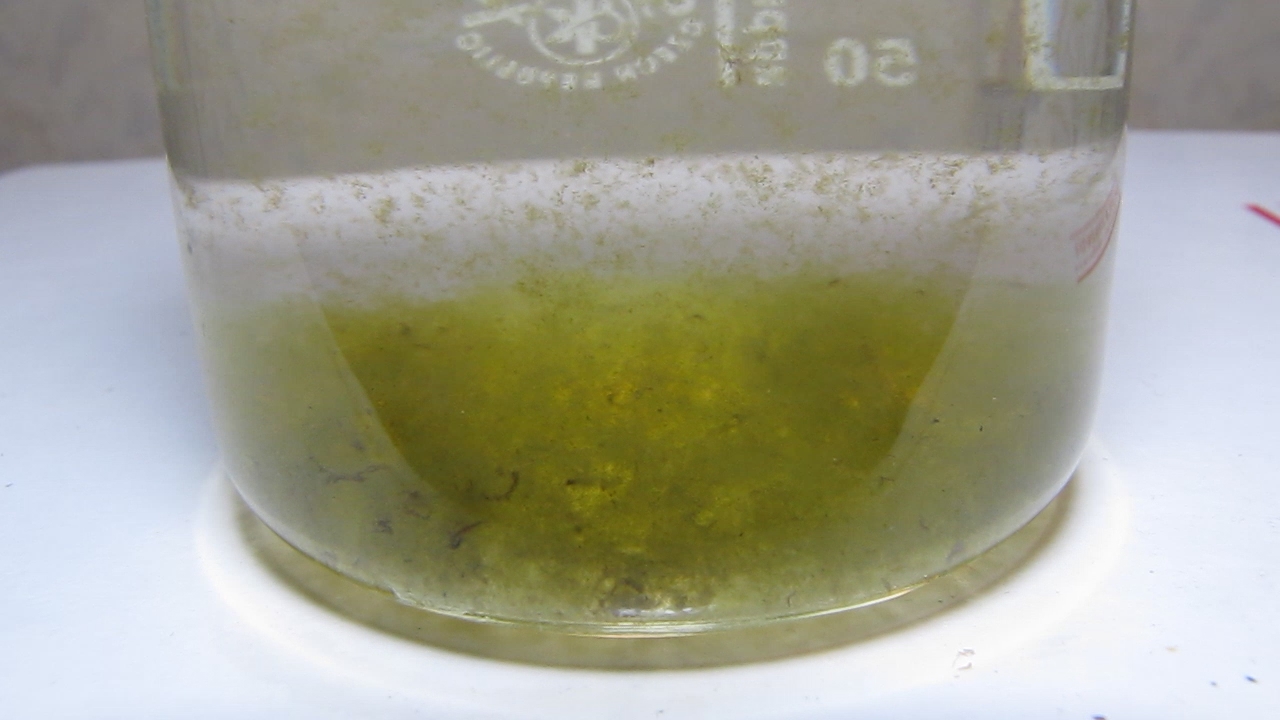
|
|
I took a new sample from the lake. This time it was also green-yellow water. Specially noted: there were no visible solid particles.
A new alkali solution was prepared, at this time: 1 g of potassium hydroxide in 2 ml of water. 200 ml of the lake water were poured into a glass, and then I began to add a solution of potassium hydroxide drop by drop, it was stirred. At first, nothing happened, then turbidity appeared, and after a few seconds, green-brown flakes formed. The flakes became big, and gradually settled to the bottom and walls, the solution became discoloured, but it remained cloudy (there was no complete clarification, at least without prolonged settling). Additional portions of potassium hydroxide solution did not seem to cause precipitation, but peptization of the precipitate: i.e., part of the precipitated solid phase again formed a suspension/colloidal solution. This behaviour is typical: at certain concentrations, the electrolyte causes coagulation of the colloidal solution and the formation of a precipitate. At other concentrations, the same electrolyte can cause the transition of the (same) precipitate into a suspension/colloidal solution (peptization). Therefore, the same electrolyte can be both a coagulant and a peptizing agent. I decided to add a saturated solution of iron (III) chloride to the solution with a precipitate in a glass - drop by drop. The first drop was added, and the liquid was stirred. Brown flakes formed and settled. The solution was colourless and cloudy. Most likely, after a long time, the solid particles would have settled completely, but I did not wait. The next drops of iron (III) chloride were added, and the solution was stirred (4 drops were added totally). The result was a lot of brown flakes, which quickly settled, and a bulky precipitate formed. Some of the flakes were still swirling in the liquid, but it was clear that the fine turbidity had disappeared - the liquid would soon clear up. On other hand, the colour of the solution turned brown. Moreover, the colour of the liquid was due not to small solid particles (a suspension) but to coloured molecules that formed a true solution (a homogeneous system) or/and to tiny particles that formed a colloidal solution (i.e., aggregates of molecules). I checked with universal indicator paper; the solution had pH >10. The medium was highly alkaline. I suppose that trivalent iron could form a soluble brown complex with organic matter. Natural water contains many kinds of organic molecules that are good ligands and easily form complexes with polyvalent metal ions (as an option, a brown organic substance that did not contain iron could pass into the solution). |
|
Отобрал новую пробу из озера. В этот раз - также зелено-желтая вода. Специально обратил внимание: видимые твердые частицы отсутствовали.
Приготовил новый раствор щелочи, в этот раз: 1 г гидроксида калия в 2 мл воды. Налил в стакан 200 мл пробы воды, стал по капле добавлять раствор едкого кали, перемешивал. Сначала - ничего, потом - помутнение, через несколько секунд образовались хлопья зелено-бурого цвета. Хлопья стали крупными, постепенно осели на дно и стенки, раствор обесцветился, но остался мутным (т.е., полного осветления не было, по крайней мере, - без длительного отстаивания). Дополнительные порции раствора гидроксида калия, похоже, вызывали не осаждение, а пептизацию осадка: т.е. часть осажденной твердой фазы снова образовывало суспензию/коллоидный раствор. Такое поведение является типичным: при одних концентрациях электролит вызывает коагуляцию коллоидного раствора и образование осадка. При других концентрациях этот же электролит может вызывать переход (этого же) осадка в суспензию/коллоидный раствор. Решил добавить к раствору с осадком в стакане насыщенный раствор хлорида железа (III) - по капле. Первая капля, перемешал. Образовались и осели бурые хлопья. Раствор - бесцветный, мутный. Скорее всего, при длительном отстаивании твердые частицы осели бы полностью, но я не стал ждать. Добавил следующие капли хлорида железа (III), перемешал (всего добавил 4 капли). Результат - много бурых хлопьев, которые быстро осели, образовался объемный осадок. Некоторая часть хлопьев еще кружилась в жидкости, но было видно, что мелкая муть исчезла, - жидкость скоро осветлиться. Зато цвет раствора стал коричневым. Причем цвет жидкости был обусловлен окрашенными молекулами, которые образовали истинный раствор или мелкими частицами, которые образовали коллоидный раствор (т.е. - агрегатами молекул), но не грубодисперсными частицами, взвешенными в жидкости (суспензия). Проверил универсальной индикаторной бумагой: рН раствора >10. Среда - сильнощелочная. Допускаю, что трехвалентное железо могло образовать с органикой растворимый коричневый комплекс. Природная вода содержит органические молекулы, которые являются хорошими лигандами и легко дают комплексы с поливалентными металлами (как вариант, в раствор могло перейти коричневое органическое вещество, которое не содержит железа). |
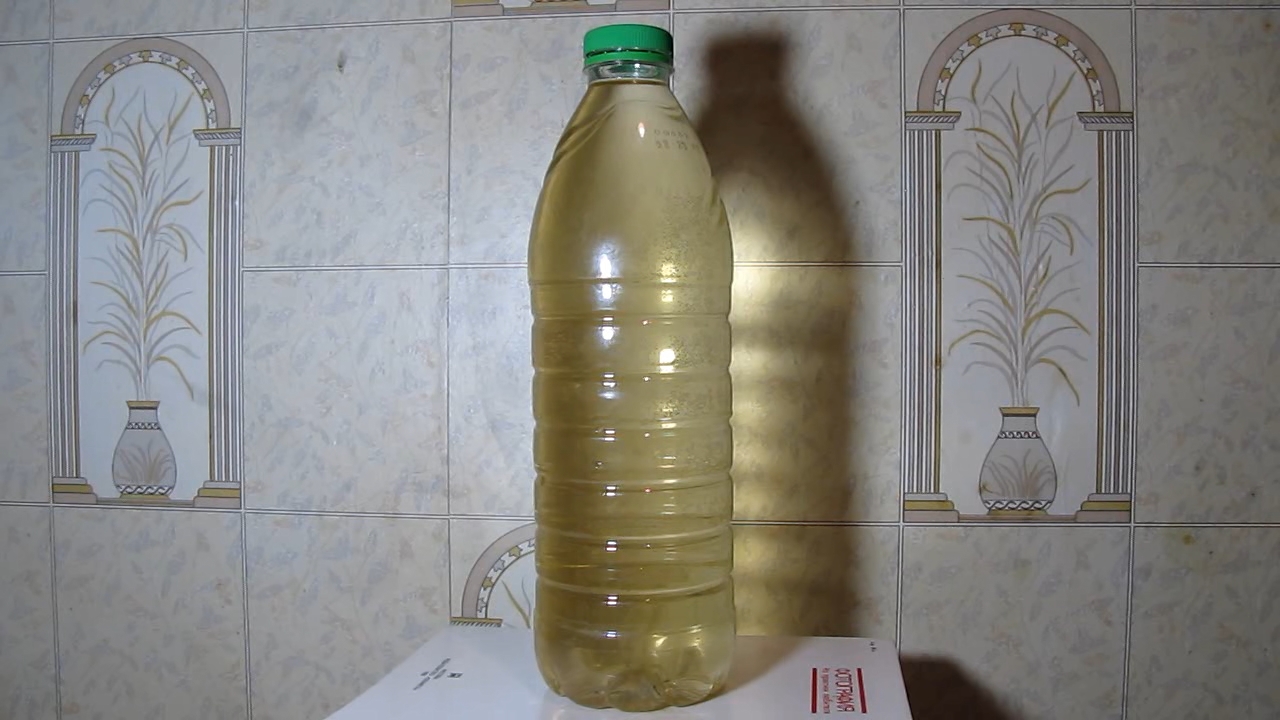
Lake water (the fresh sample), potassium hydroxide and iron (III) chloride |
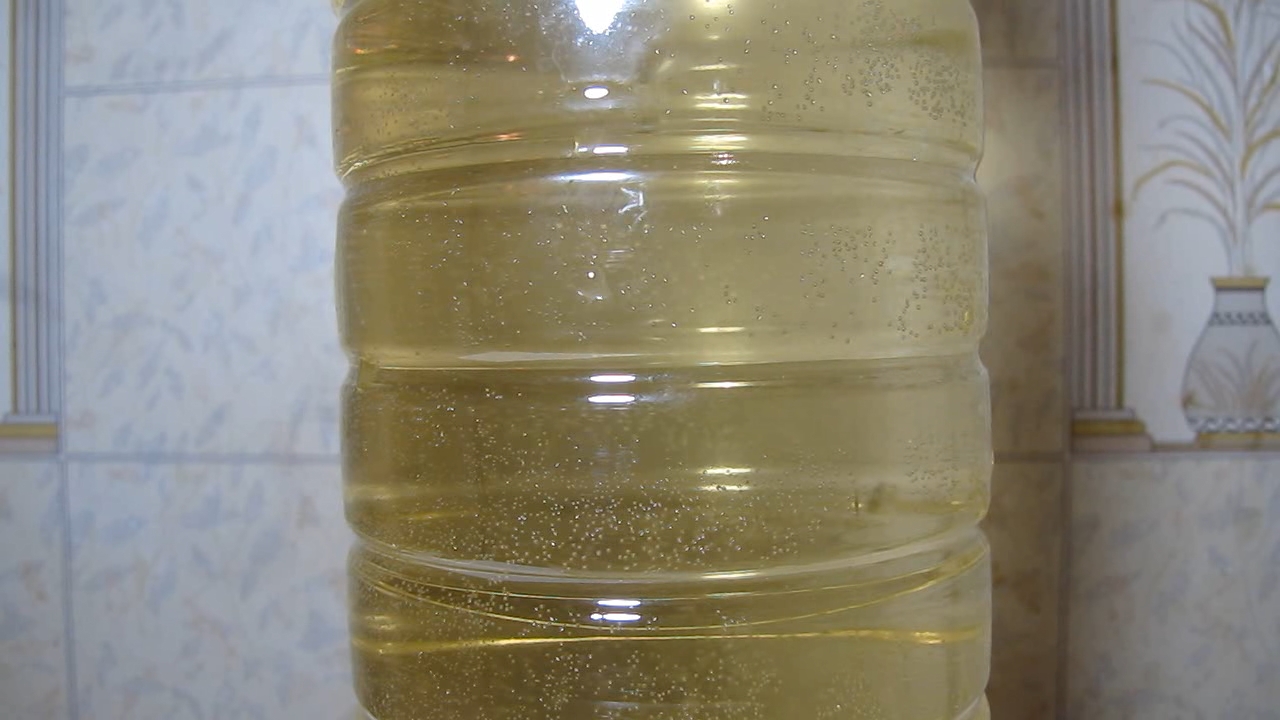
|
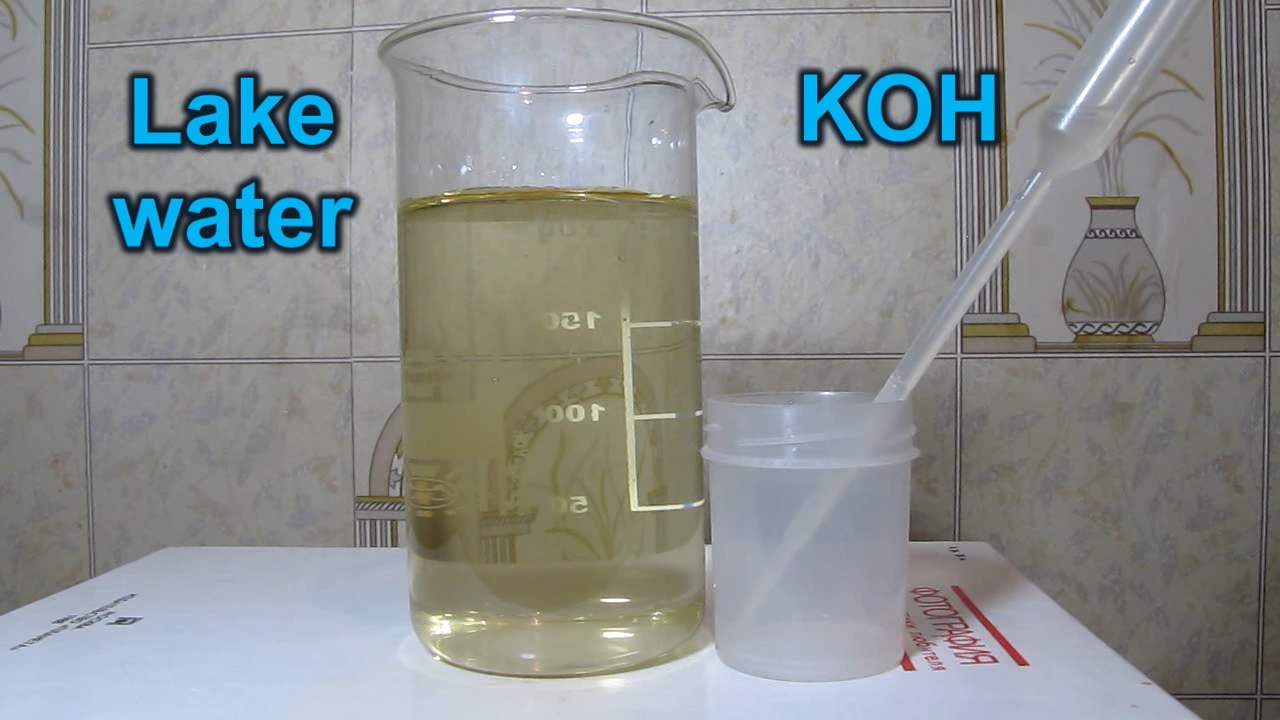
|
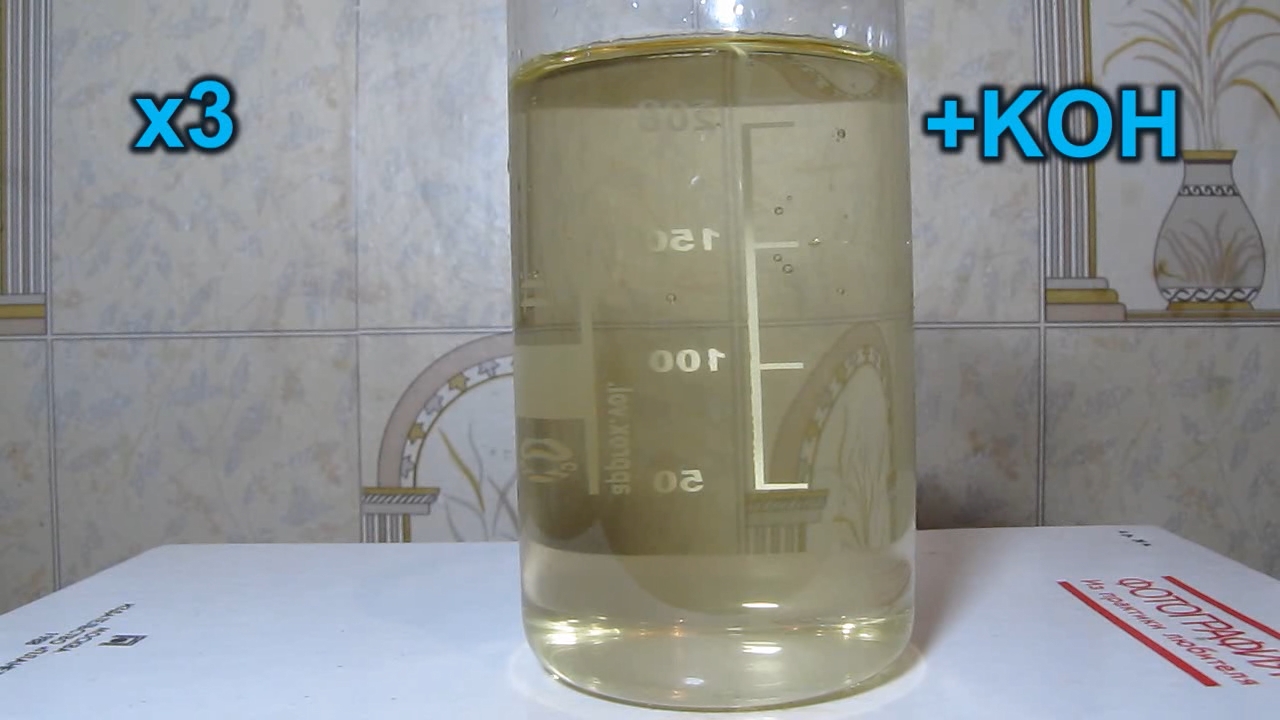
|

|
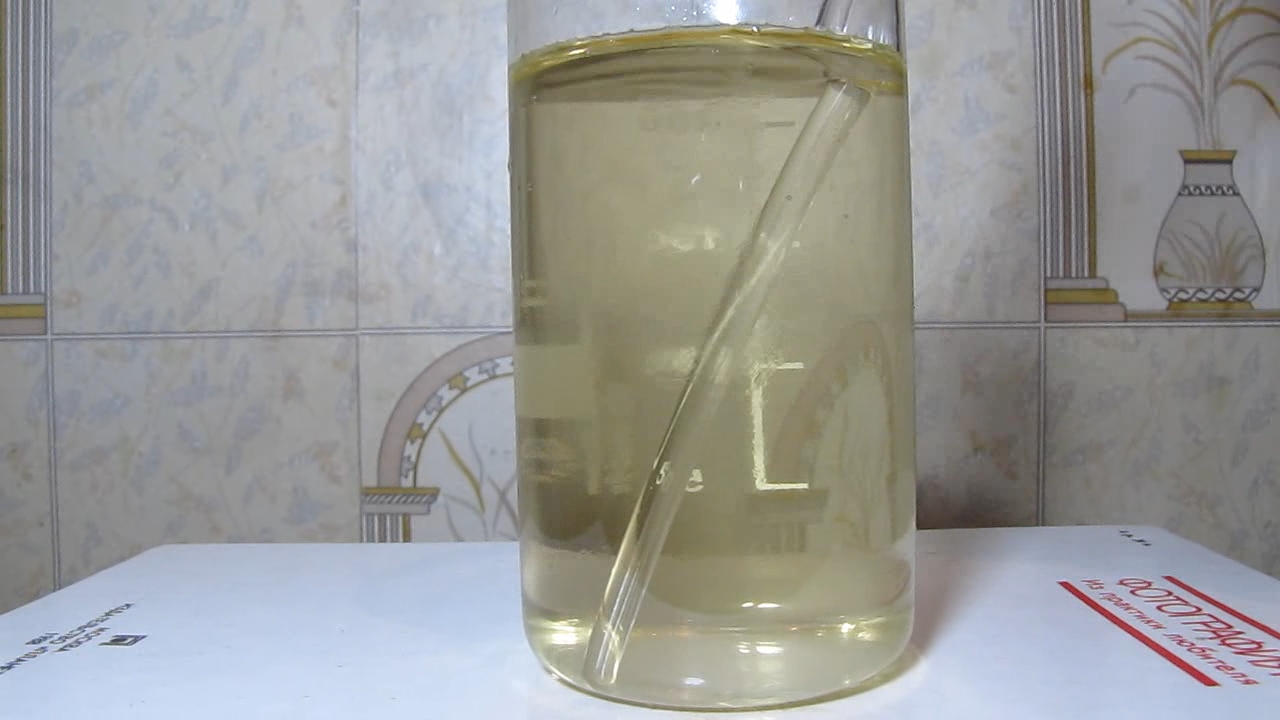
|
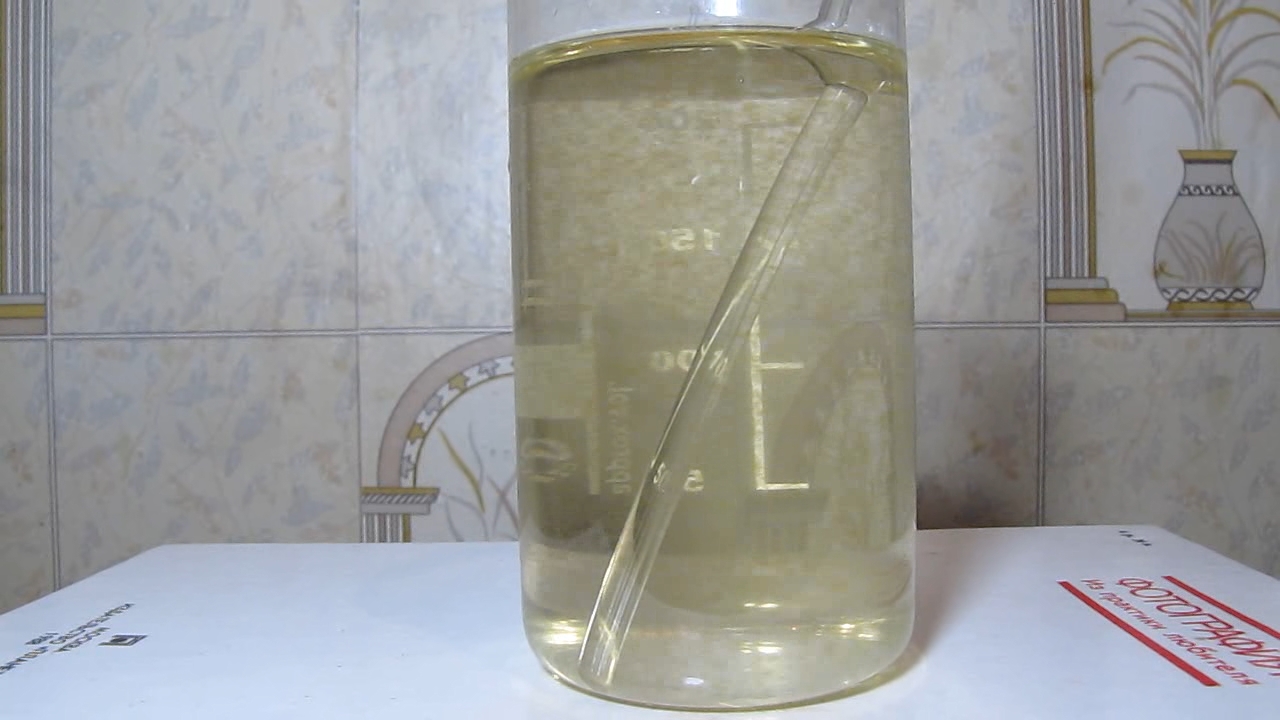
|
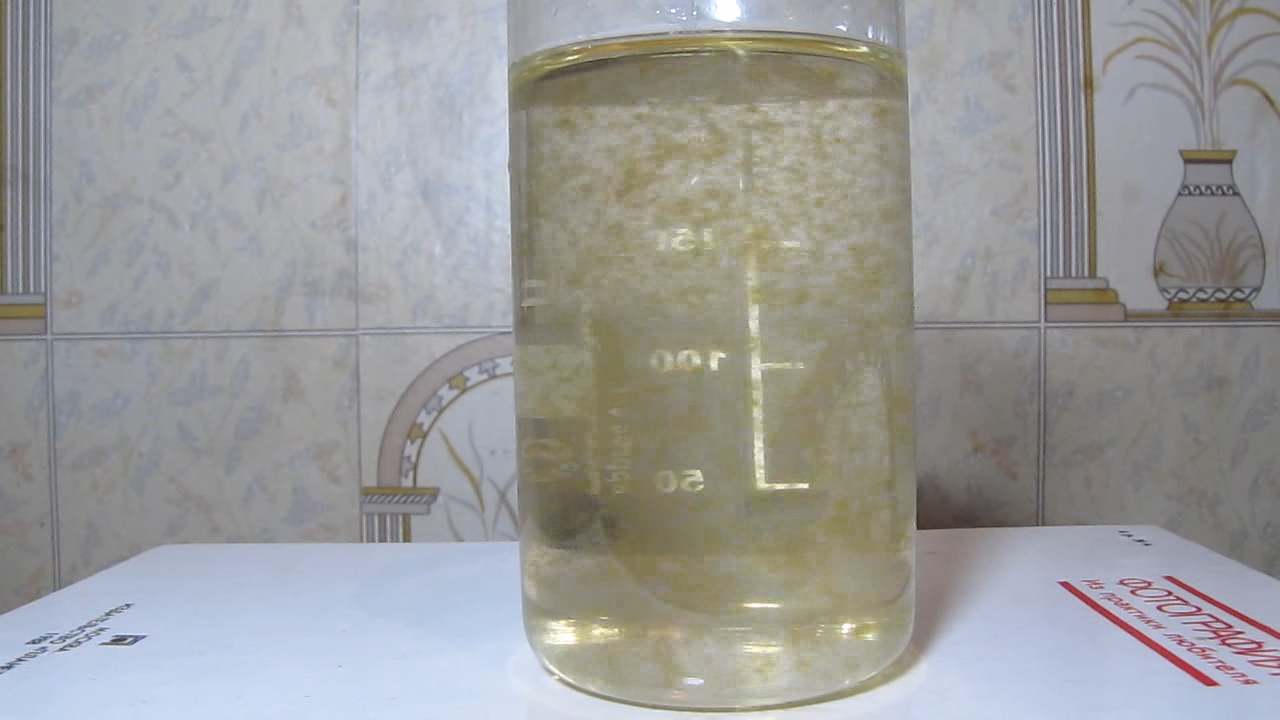
|

|

|

|

|

|
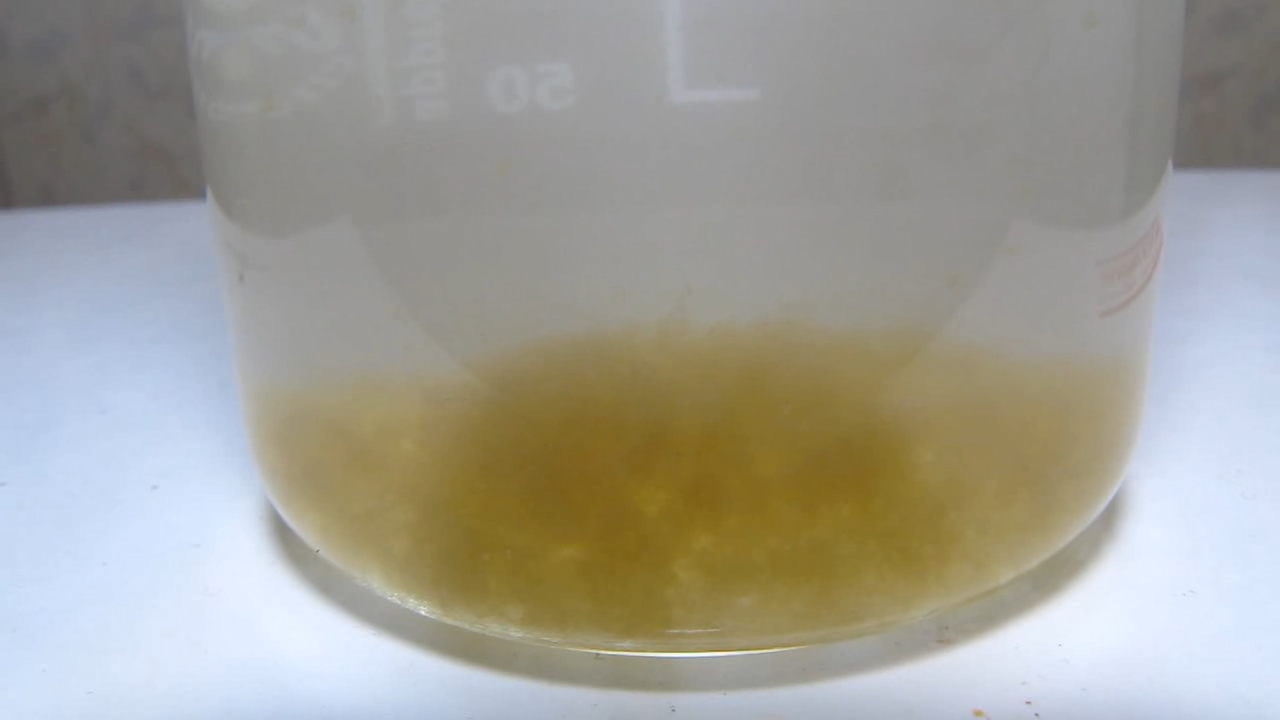
|
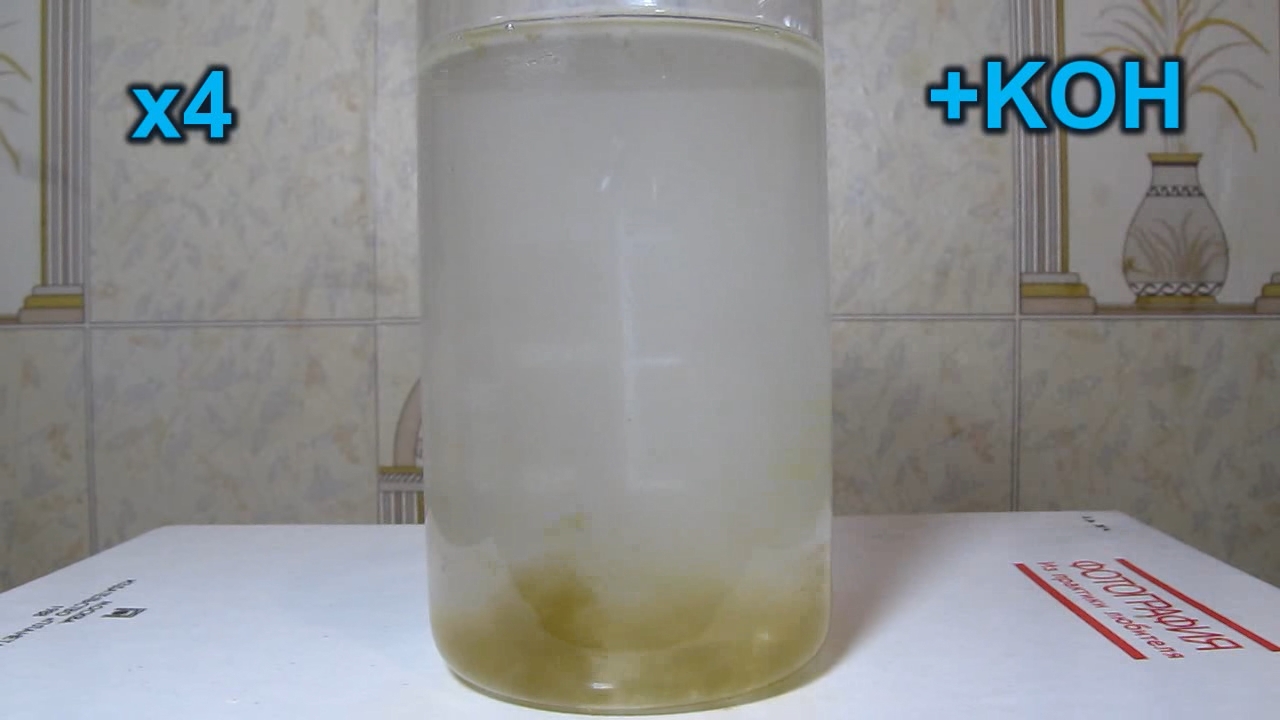
|
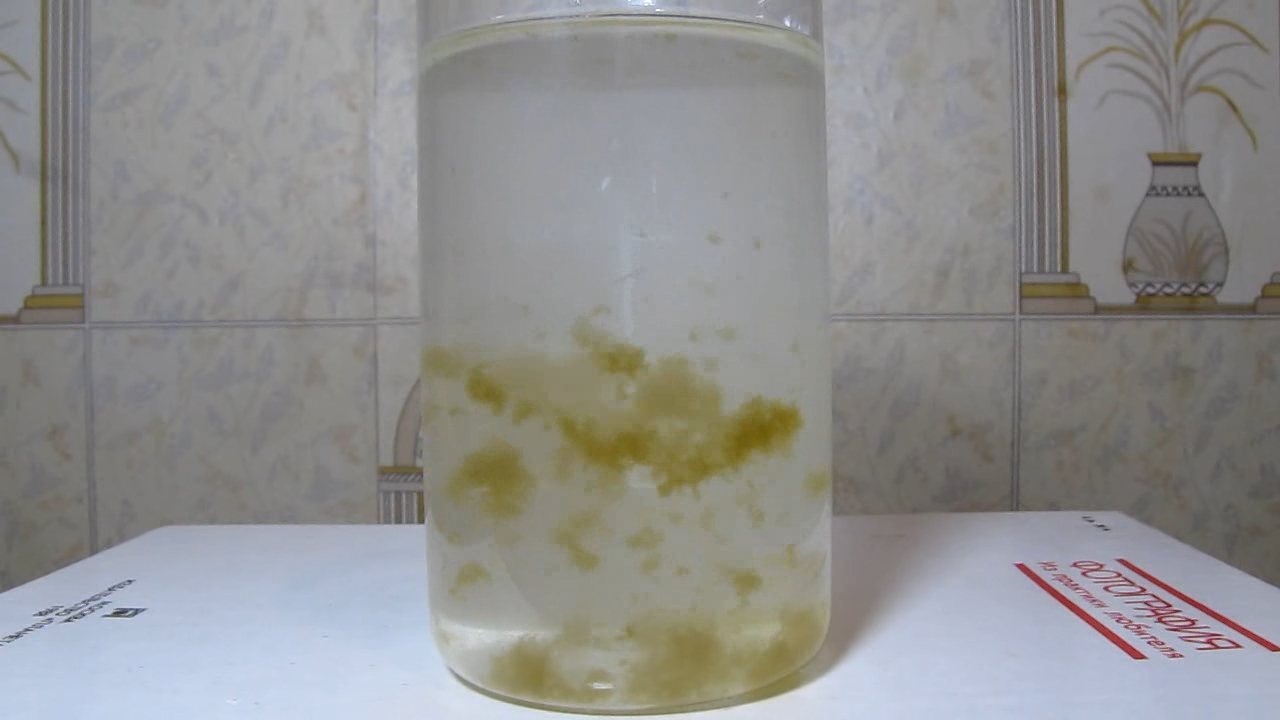
|

|

|
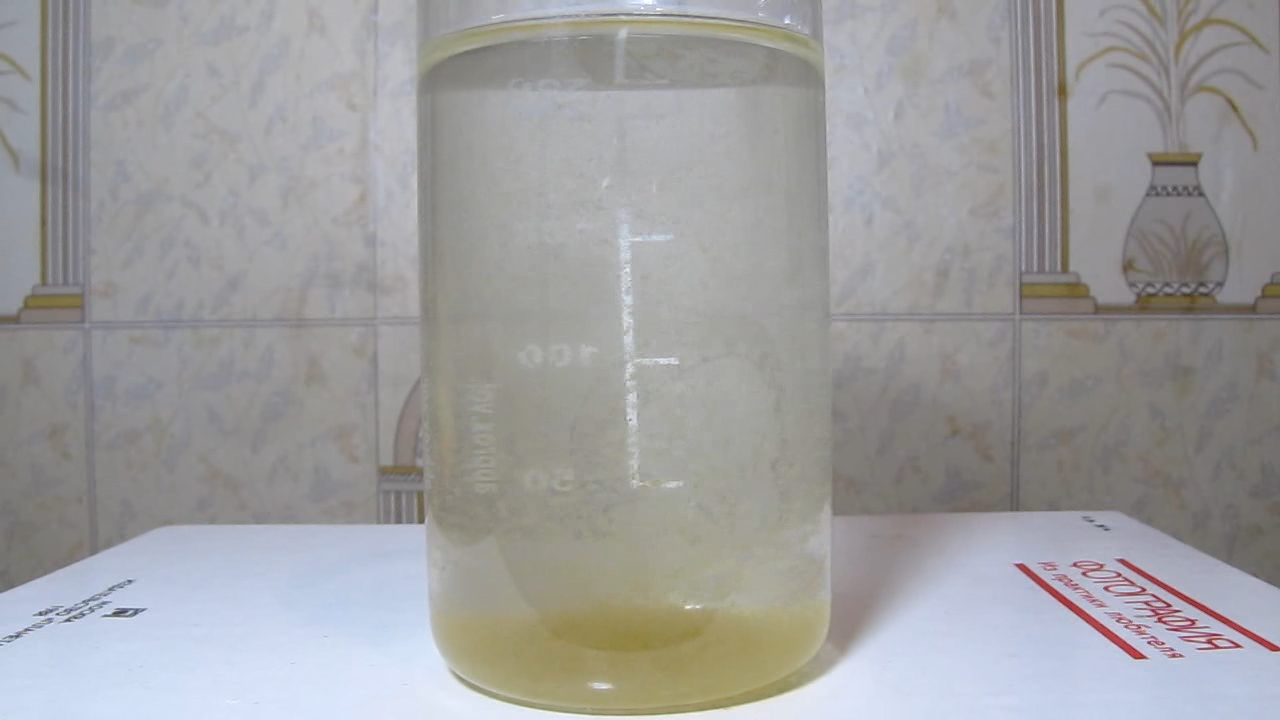
|
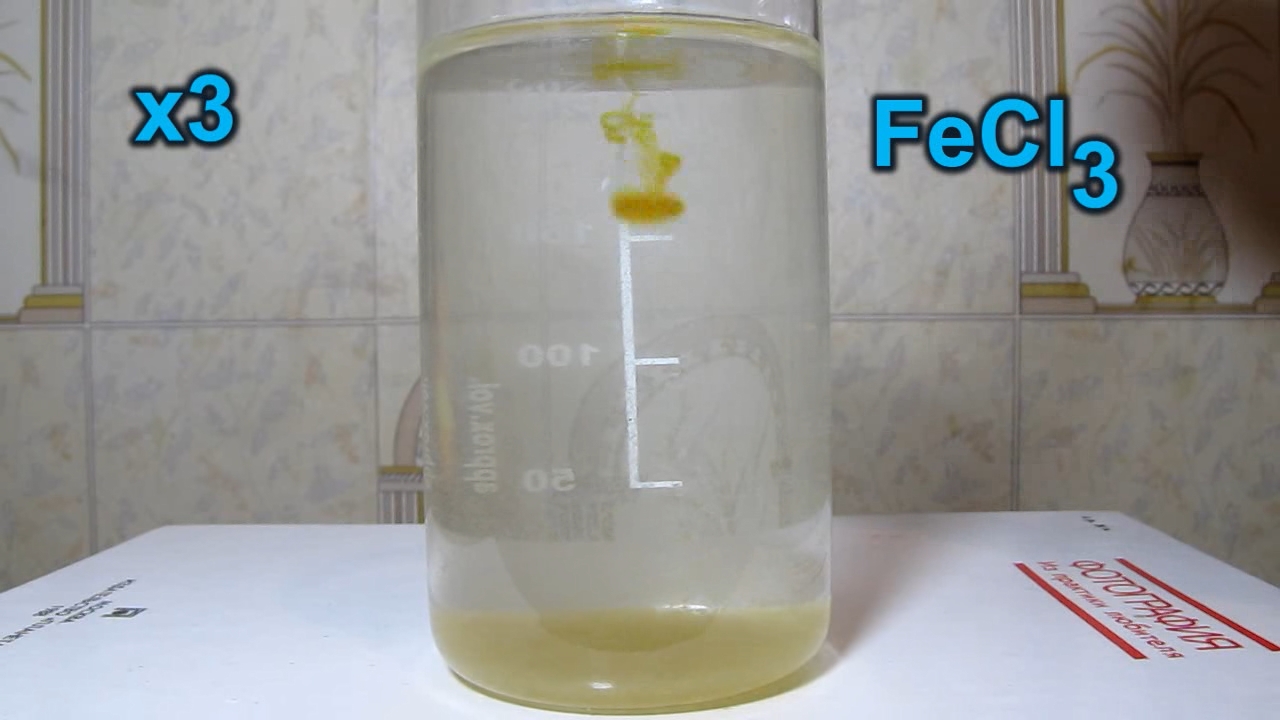
|

|

|

|
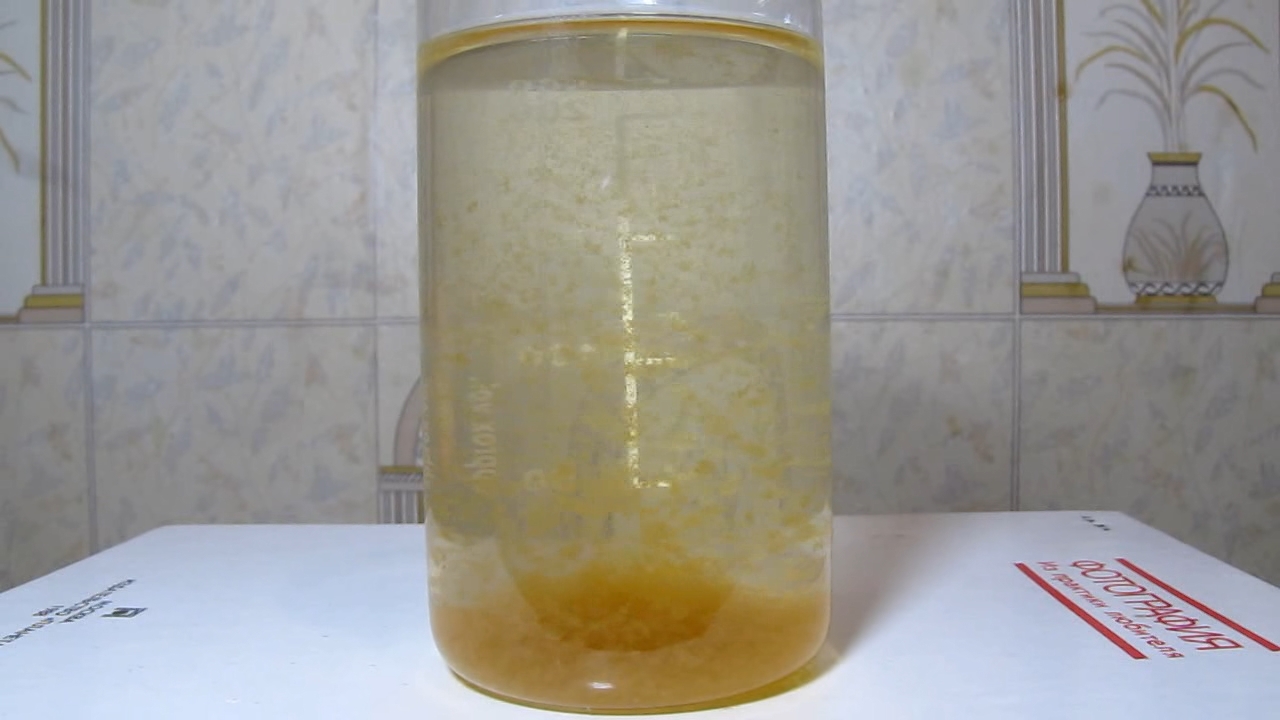
|
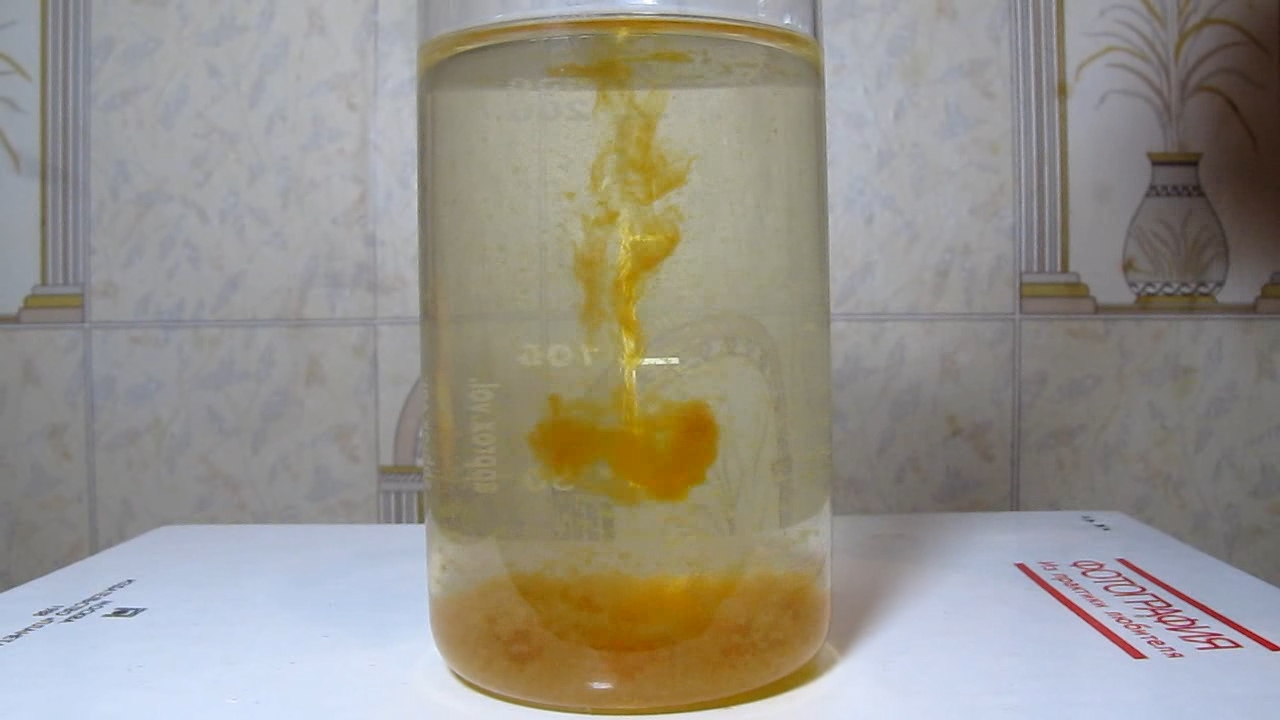
|

|
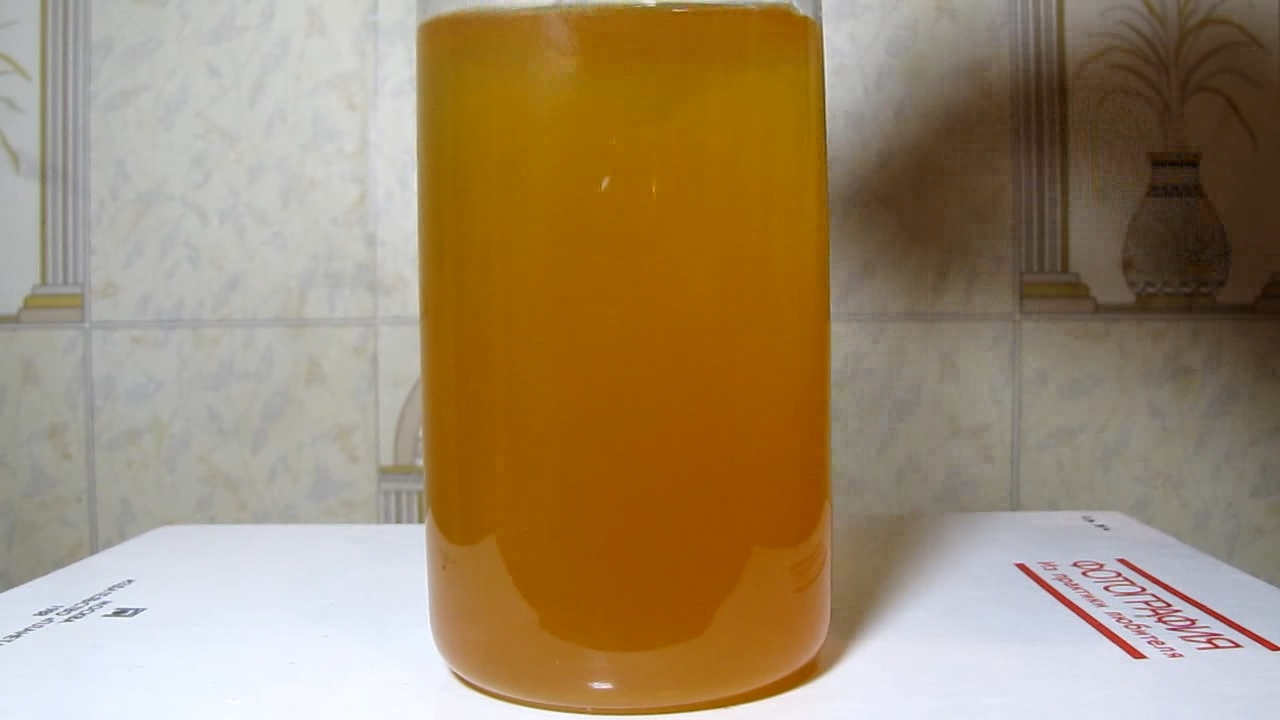
|
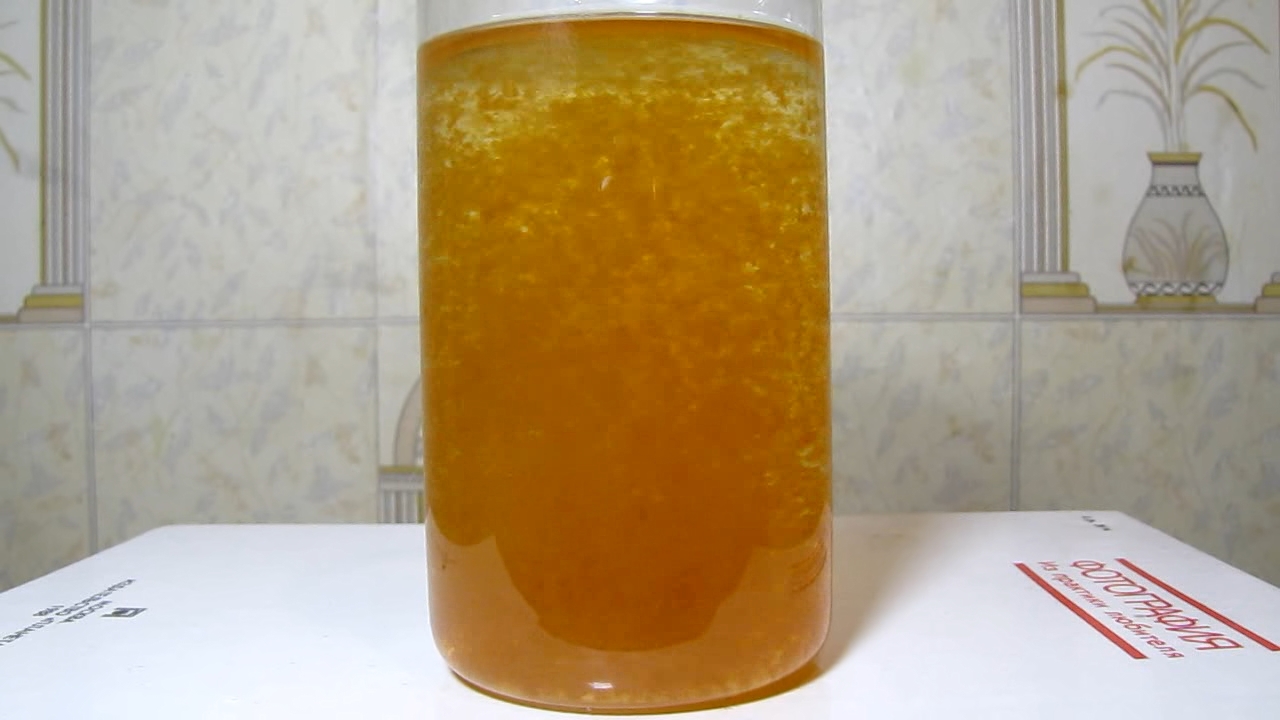
|

|
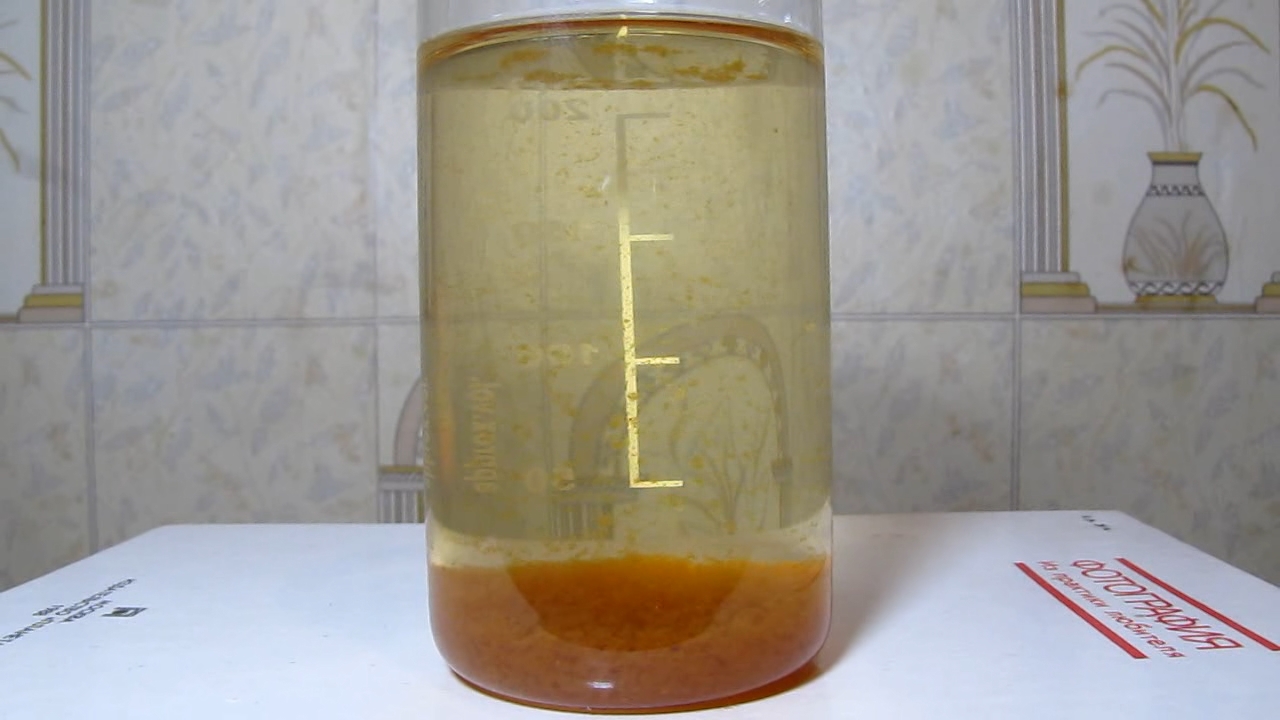
|
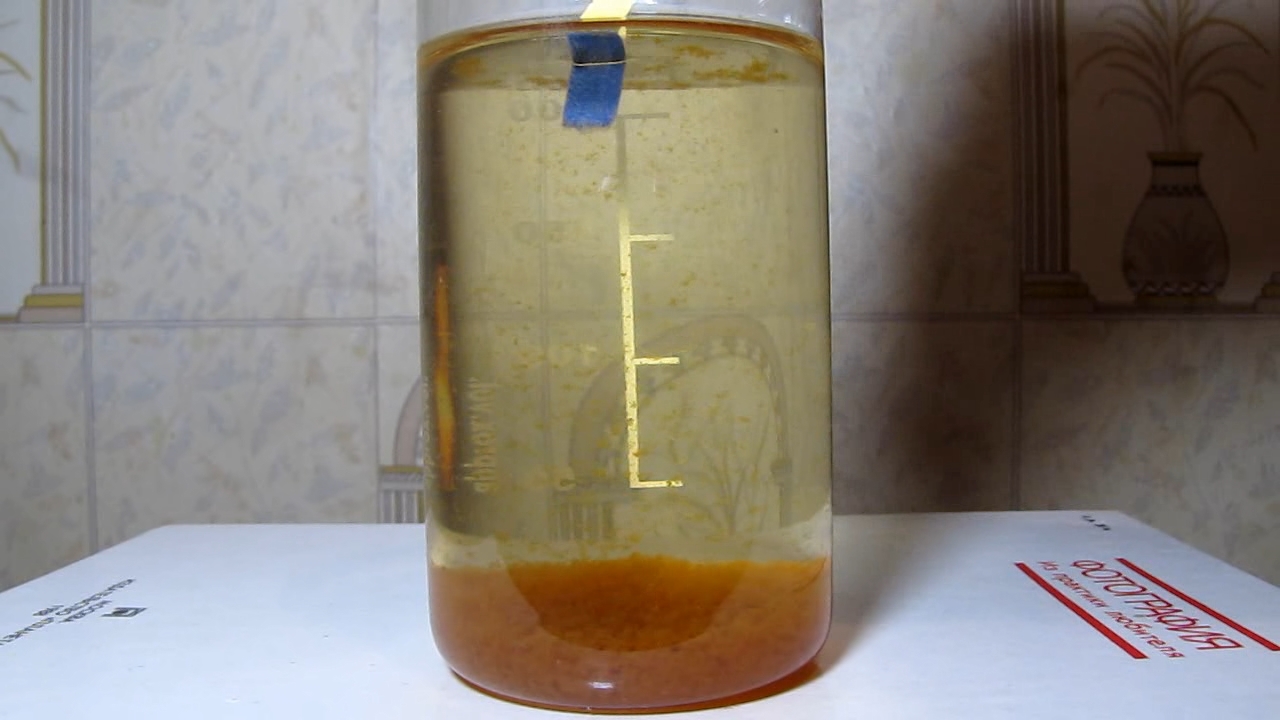
|
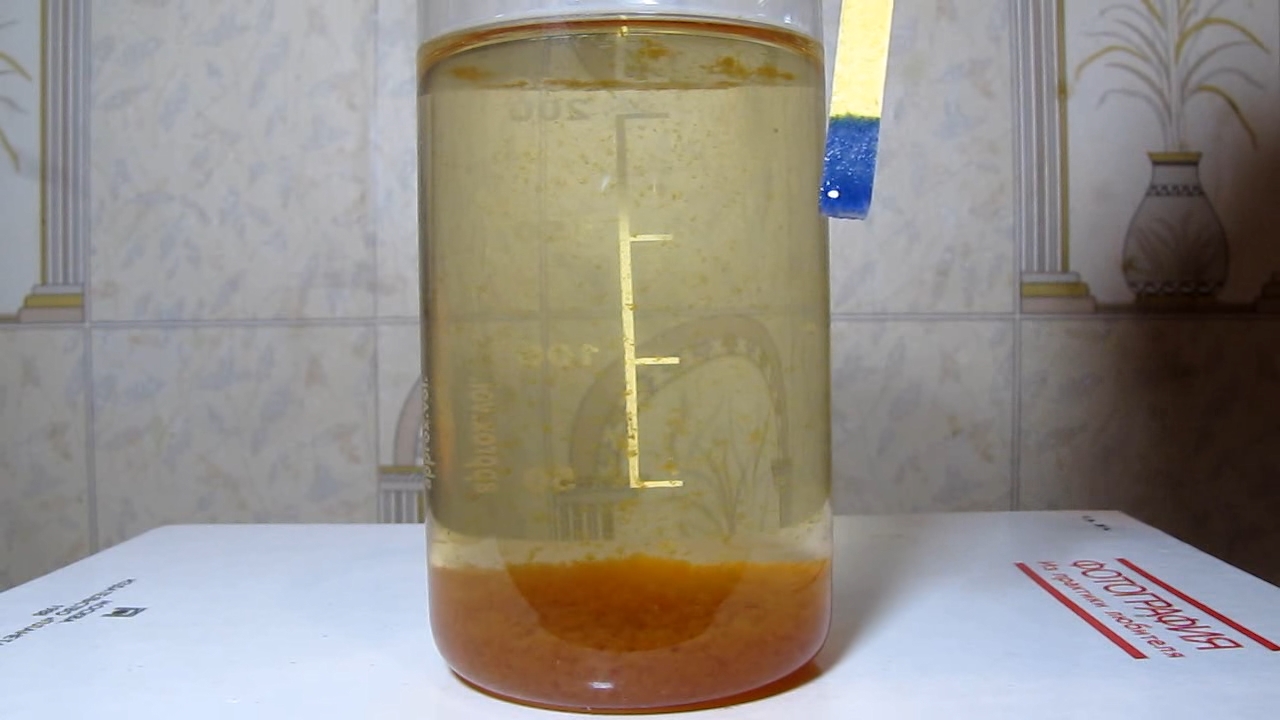
|

|
|
Как показал прошлый эксперимент, действие гидроксида калия или комбинации "гидроксид калия - хлорид железа (III)" не привели к достижению осветления и обесцвечивания воды (из озера). В первом случае вода осталась мутной, во втором - твердые частицы выпали в осадок, но вода стала еще более желтой (коричневой).
Другим щелочным реагентом, который оказался под рукой, было жидкое стекло. Это густая жидкость, которая представляет собой технический раствор силикатов натрия и калия в воде. Активно используется в строительстве. Раньше жидкое стекло массово применяли для склеивания бумаги под названием "силикатный клей". Посмотрел интернет: оказывается, что с этой целью жидкое стекло используют до сих пор (о, господи!). Проблема в том, что в местах контакта с таким "клеем" бумага со временем разрушалась. Хорошая новость: многие из "бумаг" (документов), которые плодили многочисленные конторы, лучшей участи не заслуживают. Итак, раствор силикатов натрия и калия. Хотя теоретического основания для таких прогнозов не было, но в моем воображении жидкое стекло должно легко коагулировать коллоиды (и осаждать растворенные вещества), которые содержаться в озерной воде. Во-первых, раствор - сильнощелочной, а (в прошлом эксперименте) гидроксид калия вызывал образование осадка (хлопьев) при действии на озерную воду. Кроме того, при действии кислот жидкое стекло (силикаты натрия/калия) образует золь кремниевой кислоты (коллоидный раствор). В зависимости от концентрации и количества кислоты, может также выпасть осадок кремниевой кислоты или образоваться гель. Возможно, для образования золя кремниевой кислоты достаточно действия углекислого газа, который содержится в воздухе и воде? Что будет, если смешать два коллоидных раствора? Это зависит от знака заряда их частиц. Если частицы двух коллоидных растворов заряжены противоположно, возможно слипание частиц с разноименным зарядом (взаимная коагуляция). В частности, в аналитической химии используют прием осаждения золя кремниевой кислоты, который заряжен отрицательно, действием золя желатина, который заряжен положительно. Таким способом можно быстро отделить коллоидный диоксид кремня из раствора. Разумеется, жидкое стекло не является индивидуальным химическим веществом. Его состав M2xSiyO2y+x не соответствует формуле метасиликата M2SiO3 или ортосиликата M4SiO4 (M = Na, K). В растворе содержатся анионы поликремниевых кислот, эти анионы находятся в равновесии со свободной щелочью (гидроксид натрия/калия), которая образуется в результате гидролиза. Частичная нейтрализация этой щелочи не ведет к образованию свободной кремниевой кислоты. Еще раз подчеркну: приведенные размышления с химической точки зрения - нестрогие, но основания для надежды есть. Налил в стакан 200 мл воды из озера. Добавил несколько капель жидкого стекла, перемешал. Ничего не произошло. Стал добавлять жидкое стекло большими порциями, перемешивал раствор. Добавил примерно 5 мл. Заметных изменений не произошло. Добавил 4 капли хлорида железа (III) - капля за каплей, перемешал раствор. Сначала появилась муть, потом цвет жидкости стал отчетливо желтым. Со временем осадок выпал на дно, но жидкость над ним осталась желтой (как и в случае с едким кали). При перемешивании в жидкости были заметны хлопья, которые медленно оседали. Раствор так и остался желтым. Вспомнил, что гуминовые кислоты экстрагируют из бурого угля (почвы, торфа, окисленного каменного угля) действием щелочи (гидроксиды натрия, калия, аммония). В нашем случае щелочь, видимо, действует аналогично. Щелочь удерживает гуминовые и фульвокислоты в растворе - даже в присутствии трехвалентного железа (скорее всего железо образует комплекс с данными веществами). |

Lake water, water glass and iron (III) chloride |
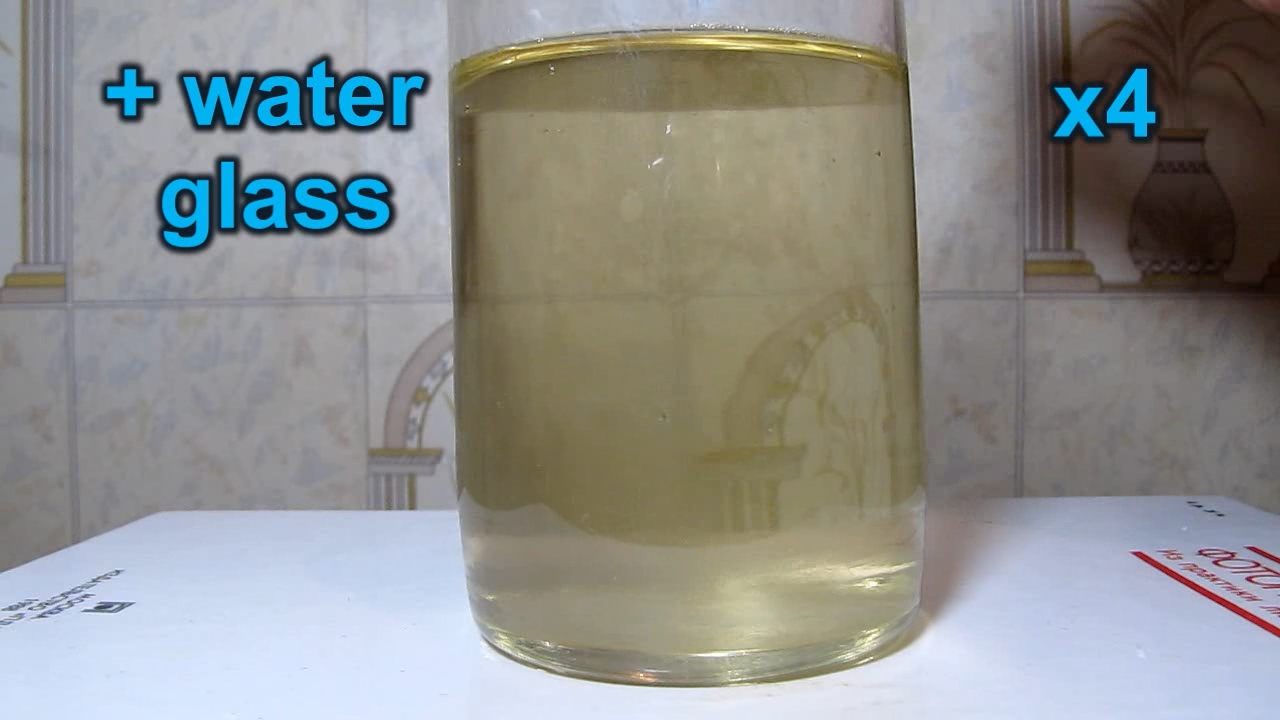
|
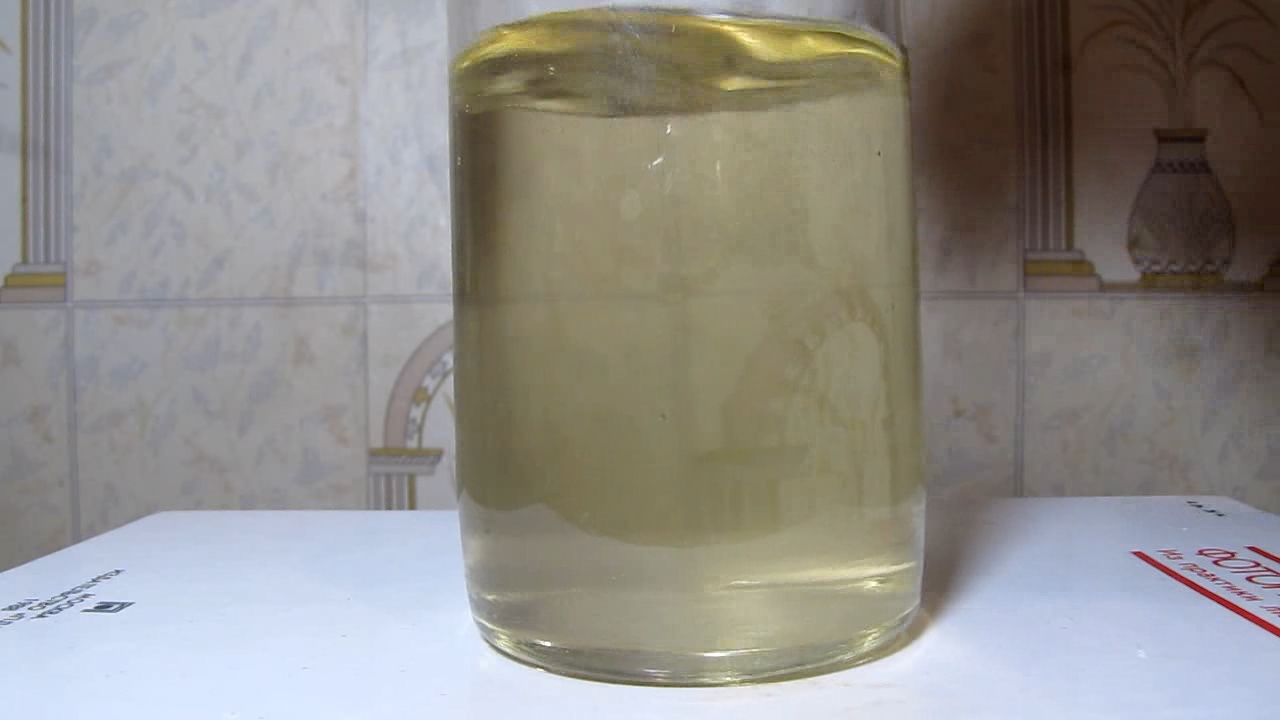
|

|
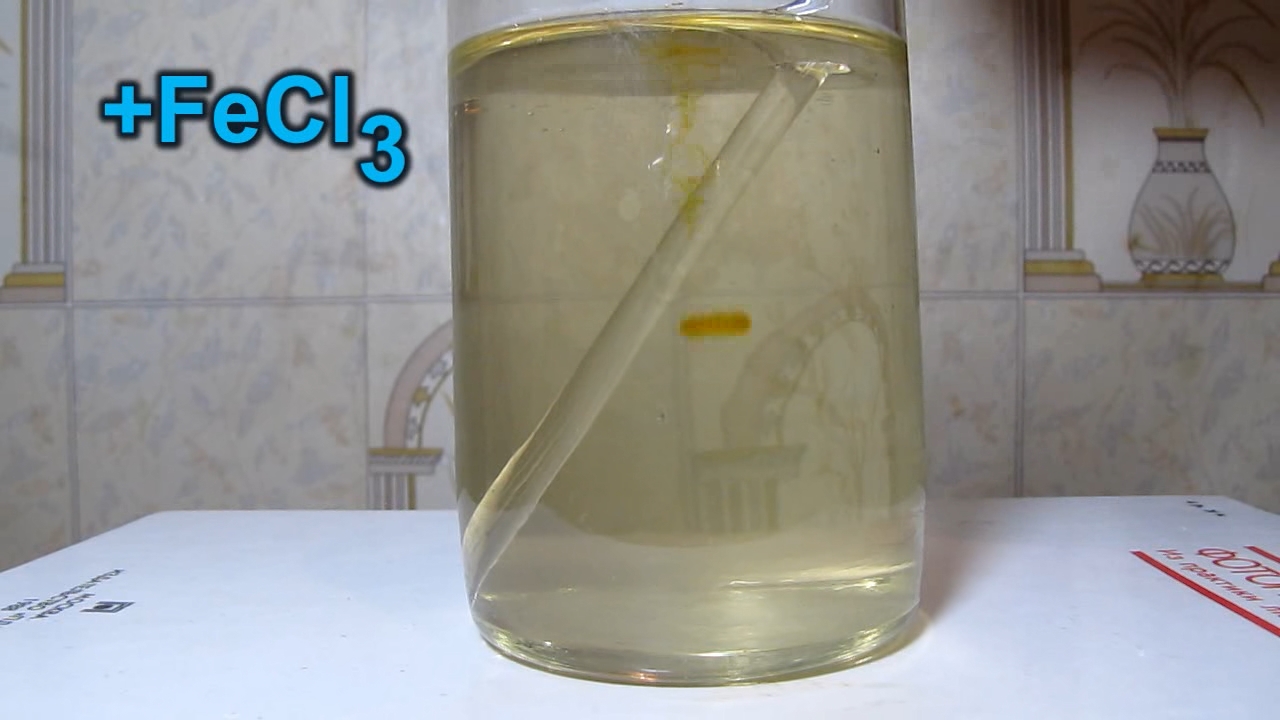
|

|

|

|

|
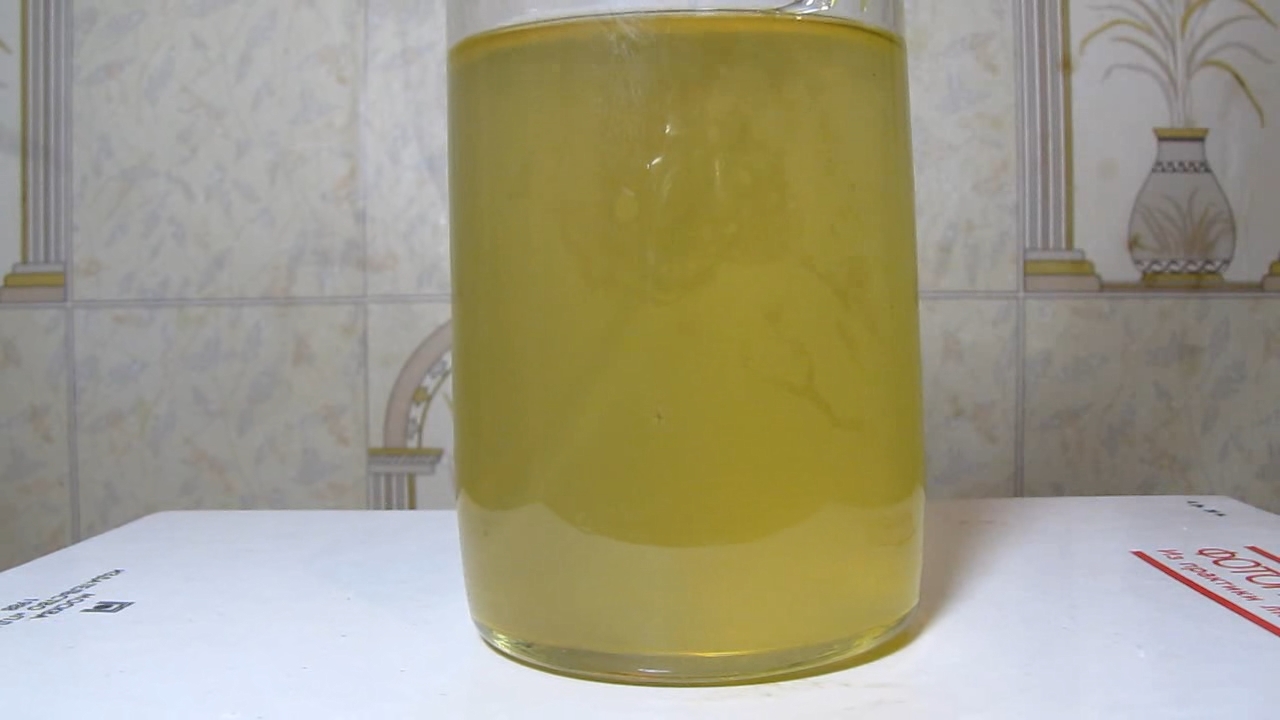
|
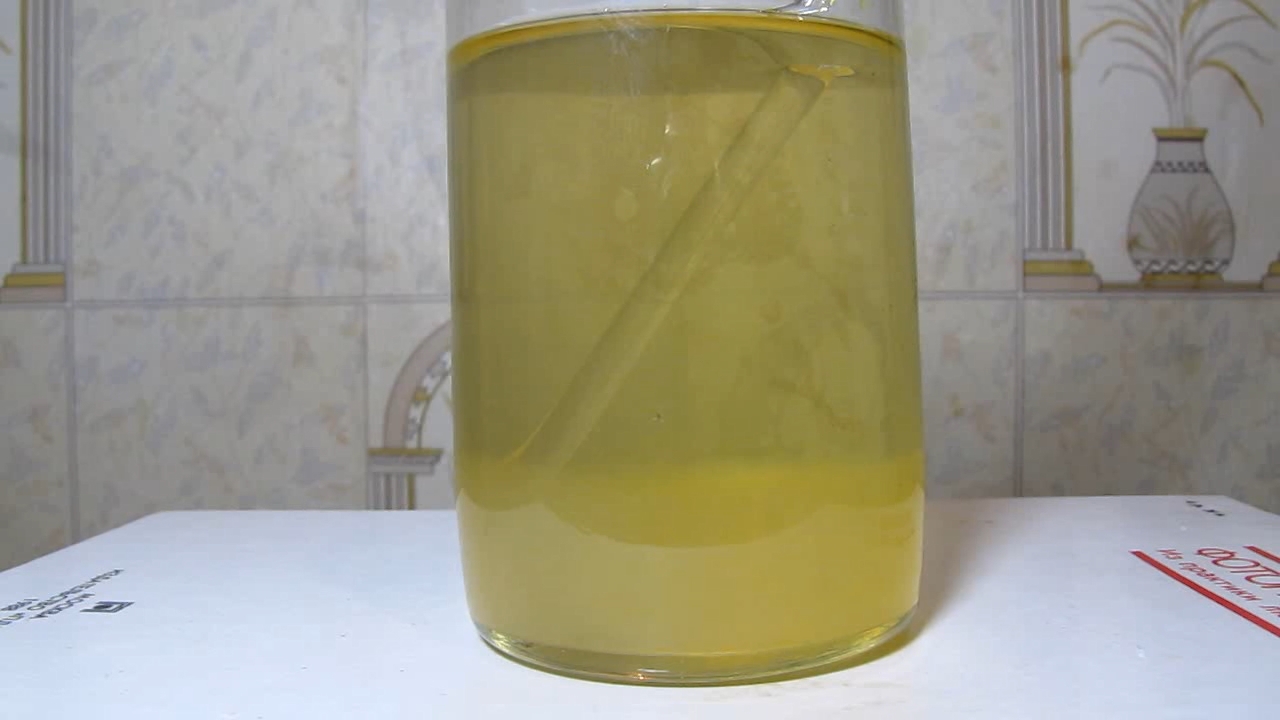
|
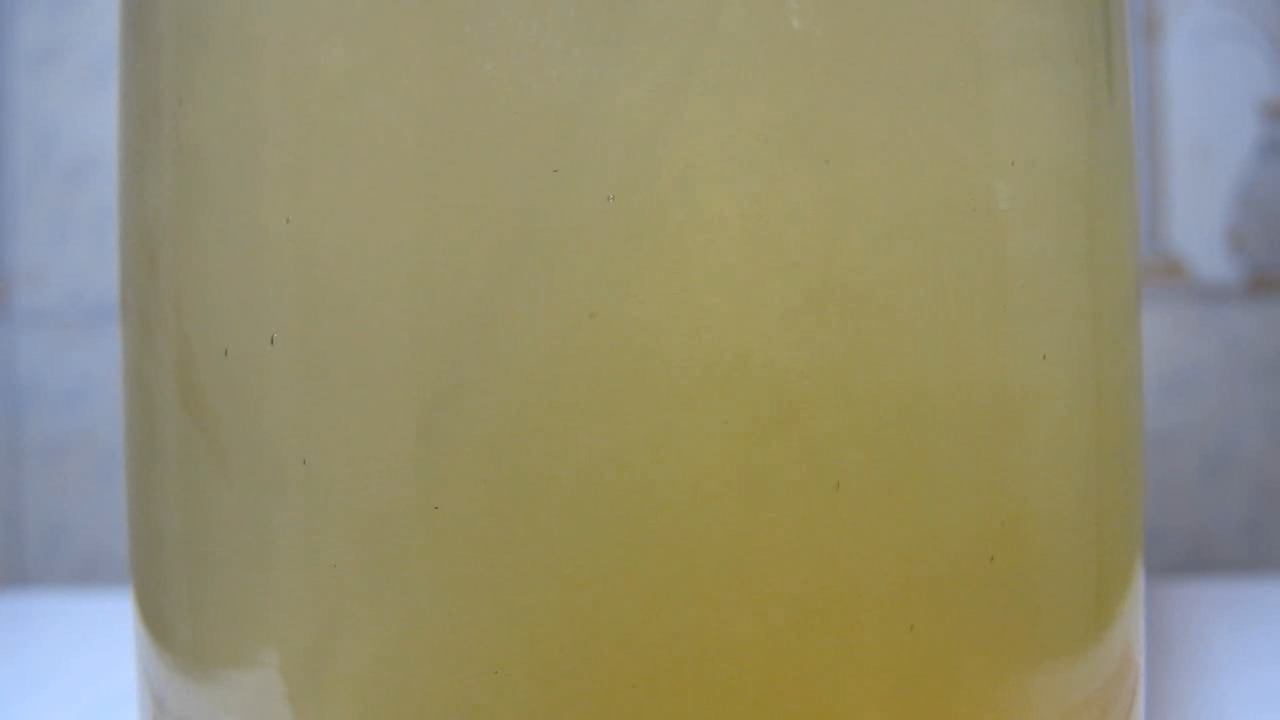
|
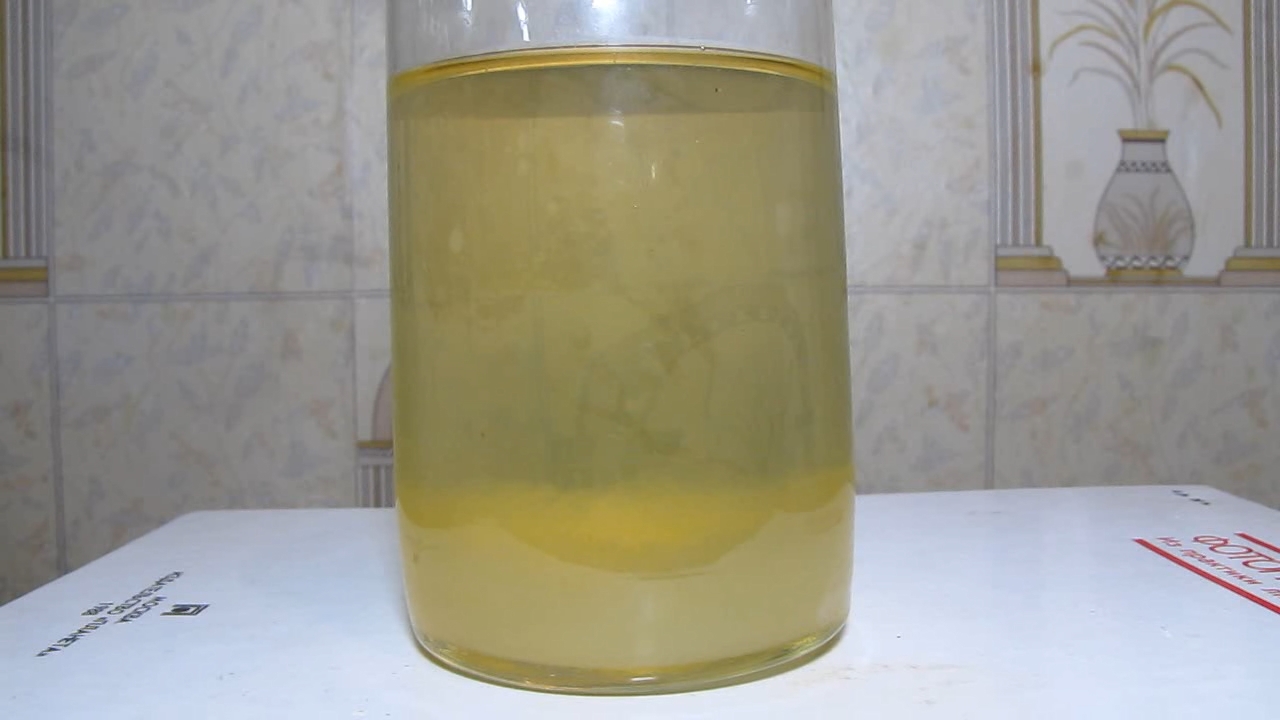
|
|
Комментарии
К1
Осадки соединений железа способны сорбировать, соосаждать вместе с собой ионы других металлов. Например, сточные воды гальванического производства подвергают электролизу со стальными электродами. Ионы меди и никеля переходят в осадок вместе с гидроксидом железа.
Или, при осаждении феррита железа, Fe3O4 (гидратированного?) из раствора, содержащего смесь ионов двух и трёхвалентного, вместе с ферритом переходят в осадок другие поливалентные ионы.
К2 "Разумеется, жидкое стекло содержит избыток щелочи (который препятствует образованию свободной кремниевой кислоты)." Это не так. Жидкое стекло содержит анионы поликремниевых кислот. Щелочная среда получается за счёт гидролиза. Характеризуется кремниевым модулем, т.е. отношением содержания кремнезёма к щелочным компонентам. Это соотношение реально не соответствует ни метасиликату, ни ортосиликату. К2-1 Согласен. Сейчас думаю, как это сформулировать в контексте статьи, а потом еще нужно будет перевести на английский (что для меня намного сложнее - даже с программами-переводчиками). |